Abstract
Children acquiring a non-negative concord language like English or German have been found to consistently interpret sentences with two negative elements in a negative concord manner as conveying a single semantic negation. Corpus-based investigations for English and German show that children also produce sentences with two negative elements but only a single negation meaning. As any approach to negative concord and negative indefinites needs to account for both the typological variation and the child data, we revisit the three most current syntactic Agree-based analyses, as well as a movement-based approach and show that they either have difficulties with the child data or face challenges in the adult language variation or both. As a consequence, we develop a novel analysis of negative concord and negative indefinites which relies on purely morphological operations applying to hierarchical semantic representations within a version of the Meaning First architecture of grammar. We will argue that the typological variation between the main three different types of languages as well as the children’s non adult-like behaviour fall out from this in a straightforward fashion while the downsides of the Agree- and the movement-based accounts are avoided.
1. Introduction
Languages vary in how they express negated indefinites. The relevant literature has largely discussed three types of languages; strict negative concord (strict-NC), non-strict negative concord (non-strict NC), and non-negative concord languages (non-NC, also known as double negation languages) (Deal 2022b; Giannakidou 1998; Penka 2011; Zeijlstra 2004, among many others). Strict-NC languages, like Czech, use sentences containing both a sentential negation marker (henceforth negative marker) and a negatively marked indefinite, a so-called ‘Negative Concord Item’ (NCI). The occurrence of the negative marker is independent of the position of the NCI, as shown in (1). Other languages that have been classified as strict-NC languages are, for instance, Bosnian/Croatian/Serbian (BCS), Greek, Hebrew, Hungarian, Polish, Romanian, Russian and Turkish.
| (1) | Strict-NC (Czech): | |||||
| a. | Nikdo | ne-volá. | single neg reading | |||
| nobody | neg-call | |||||
| ‘Nobody calls.’ | (Zeijlstra 2004, p. 214) | |||||
| b. | Ne-volá | nikdo. | single neg reading | |||
| neg-call | nobody | |||||
| ‘Nobody calls.’ | (Zeijlstra 2004, p. 251) | |||||
| c. | Dnes | nikdo | ne-volá | nikoho. | single neg reading | |
| today | nobody | neg-call | nobody | |||
| ‘Today nobody calls anybody.’ | (Giannakidou and Zeijlstra 2017, p. 9) | |||||
For non-strict NC languages, like Italian, the presence of a negative marker depends on whether the NCI is pre- or post-verbal. Specifically, as shown in (2a), when the NCI is post-verbal, a negative marker is present, however, when it is pre-verbal, it is not (2b). Moreover, a preverbal NCI voids the need for a negative marker even if there is also a postverbal NCI present (2c). Other languages that fall into this category include Portuguese, Spanish, West Flemish, and possibly also Catalan, whose classification is difficult, however, as it optionally allows the negative marker to appear with preverbal NCIs, as in strict NC-languages (see e.g., Espinal 2000; Vallduví 1994).
| (2) | Non-strict NC (Italian): | |||||
| a. | Non | ha | telefonato | nessuno. | single neg reading | |
| neg | has | called | nobody | |||
| ‘Nobody called.’ | (Zanuttini 1991, p. 111) | |||||
| b. | Nessuno | ha | visto | Mario. | single neg reading | |
| nobody | has | seen | Mario | |||
| ‘Nobody saw Mario.’ | (Zanuttini 1991, p. 111f.) | |||||
| c. | Nessuno | ha | detto | niente. | single neg reading | |
| nobody | has | said | nothing | |||
| ‘Nobody has said anything.’ | (Zanuttini 1991, p. 108) | |||||
Finally, in non-NC languages like German a single negated indefinite (referred to as a ‘negative indefinite’ (NI) in such languages) is sufficient to express semantic negation independent of its position, as shown in (3). That is, no negative marker is present. More languages instantiating this type are e.g., Dutch and Standard English (English for short), and, to some extent, also the Scandinavian languages.
| (3) | Non-NC (German): | |||||||
| a. | Peter | hat | niemanden | ngesehen. | single neg reading | |||
| Peter | has | nobody | seen | |||||
| ‘Peter saw nobody.’ | (Penka 2020, p. 134) | |||||||
| b. | Kein | Student | hat | die | Prüfung | bestanden. | single neg reading | |
| no | student | has | the | exam | passed | |||
| ‘No student passed the exam.’ | (Penka 2020, p. 125) | |||||||
In addition, certain combinations of negated indefinites or a negative marker plus a negated indefinite in non-strict NC languages as well as non-NC languages give rise to double negation readings. In a non-strict NC language like Italian, for instance, the cooccurrence of a preverbal NCI and a negative marker results in a double negation meaning as in (4) given an appropriate context and strong primary stress on the NCI (cf. Tagliani 2019).1
| (4) | Non-strict NC (Italian): | ||||
| NESSUNO | non | ha | mangiato. | double neg reading | |
| nobody | not | has | eaten | ||
| ‘Nobody didn’t eat’ = ‘Everybody ate.’ | (Penka 2011, p. 19) | ||||
Likewise, if a negative indefinite cooccurs with another negative indefinite (5a) or a negative marker (5b) in a non-NC language like German, the resulting sentence, though marked, conveys a double negation meaning. Commonly, this type of sentence in a DN language requires an appropriate context and a special prosody (cf. Pilar et al. 2015 for English and Nicolae and Yatsushiro 2022 for German).
| (5) | Non-NC (German): | ||||||||
| a. | … | dass | niemand | kein | Auto | hat. | double neg reading | ||
| that | nobody | no | car | has | |||||
| ‘… that nobody has no car.’ = ‘… that everybody has a car.’ | (Penka 2007, p. 277) | ||||||||
| b. | … | dass | ich | nicht | nichts | gegessen | habe. | double neg reading | |
| that | I | not | nothing | eaten | have | ||||
| ‘… that I didn’t eat nothing.’ = ‘… that I ate something.’ | (Penka 2011, p. 107) | ||||||||
A note on English is in order. While Standard English is traditionally analyzed as a non-NC language, NC is pervasive across English dialects, most prominently shown for UK-varieties (Tubau 2016), Appalachian English (Blanchette 2015), and African American English (Green 2002; Labov 1972). The indefinites in (6) receive low scope and can be attributed single negation readings but given the right context and prosody may also be interpreted as double negation.
| (6) | English dialects: | ||
| a. | I don’t know nothing about that. | (Appalachian English, Blanchette 2015, p. 15) | |
| b. | So it didn’t cost nothing. | (Isle of Man, Tubau 2016, p. 159) | |
Even speakers of Standard English have been shown to accept single negation readings of sentences containing a NCI and a negative marker, although it should be pointed out that acceptability rates of such structures were overall quite low (Blanchette and Lukyanenko 2019a; Blanchette 2017). These recent findings can be taken to show that English (and its dialects) generally shows optionality between NC and non-NC clauses. The rarity of NC in Standard English is then attributed to the fact that NC clauses are socially stigmatized, and thus dispreferred to clauses without NC. Note that under this view English and its dialects do not fit the standard classification as they neither pattern with NC grammars nor non-NC grammars. One crucial difference lies in the fact that NC sentences like (6) are produced alongside non-NC sentences. This optionality is absent in NC grammars, where a negative marker has to co-occur with a NCI. Likewise, non-NC grammars do not allow for optional NC clauses alongside non-NC utterances. Another difference can be found in the interpretation of NC clauses in English (dialects), as they allow single negation readings in addition to double negation readings (shown by Blanchette 2015, p. 18 for Appalachian English). Non-NC grammars exclude single negation readings for utterances like (5), whereas NC grammars are often reported to exclude double negation readings for structures such as (5b), as is for instance shown for Hungarian (Puskás 2012, p. 613) and Romanian (Iordăchioaia and Richter 2015, pp. 610–11). Given all this, we treat English and its dialects as essentially hybrids since they show traits of both NC and non-NC grammars.2 We will propose in Section 4.2 that the optionality between NC and non-NC found in English can be captured in our approach by a partial instead of total rule ordering.3
Children are faced with the challenge of having to work out which type of language they are acquiring. There is some research investigating children’s performance in meeting this challenge when acquiring a non-NC language. This work has found that children learning such languages behave non adult-like in comprehension and production such that they appear to be treating the relevant sentences as negative concord constructions. Taking these findings to indicate that there is a phase of acquisition during which children acquiring a non-NC language entertain a grammar that allows (though not forces) NC, we believe that current theoretical approaches to negative concord and negative indefinites should capture both the typological variation of NC (and NIs) in adult languages as well as the children’s productions. Since the predominant approaches in the literature are based on the syntactic operation Agree, we will evaluate three analyses of negative concord and negative indefinites which are variations on that theme, namely, Zeijlstra (2004, 2011), Penka (2007, 2011) and Deal (2022b). As an alternative syntactic approach that does not rely on Agree we also discuss Blanchette’s (2015) and Robinson and Thoms’ (2021) movement-based account. We will show that all approaches suffer from drawbacks, leading us to propose a novel analysis of negative concord and NIs which relies on purely morphological operations instead of syntactic Agree or movement. Adopting a version of the Meaning First model of grammar (Guasti et al. 2023; Sauerland and Alexiadou 2020) which provides a direct interface between semantic representations and the morphological component, we semantically decompose NIs into a neg part, an exists part and a variable part such that neg and exists are always in a local configuration above the propositional level. We introduce three morphological rules, neg-duplication, neg-deletion and bundling, which operate on this structure in different (total or partial) orders of application in distinct languages. We argue that the typological variation between the three different types of languages as well as the children’s NC-type productions fall out from this account in a straightforward fashion, while at the same time it avoids the downsides of the syntactic accounts.
The paper proceeds as follows. In Section 2, we present results from previous work on the comprehension and production of negation and negated indefinites as well as results of a recent corpus study on the spontaneous speech of English- and German-acquiring children (Hein et al. 2023), which we further enrich with data from Dutch children’s corpora. Section 3 introduces and critically discusses three current Agree-based approaches to NC and negated indefinites and one movement-based account with a particular focus on whether and how they can capture the typological variation as well as the observed NC productions in acquisition. Next, we will develop our purely morphological account of NC and negated indefinites in Section 4 before Section 5 concludes the paper.
2. Comprehension and Commission Errors with Negated Indefinites
2.1. Previous Work
Let us begin by reporting some of the previous work on children’s comprehension and production of sentences with multiple negative elements. Thornton et al. (2016) investigated the interpretations that children acquiring English, a non-NC language, would assign to sentences like (7), that is, to sentences containing both a negative marker and a NI. Adult English-speakers would typically interpret the sentence in (7) as conveying the double negation meaning paraphrased in (7a). Specifically, Thornton et al. (2016) were interested in whether children would follow adults in assigning such sentences the double negation interpretation paraphrased in (7a), or whether they might rather assign the NC interpretation paraphrased in (7b).
Thornton et al. (2016) found that children assigned a NC interpretation (i.e., (7b)) to such sentences 75% of the time. This contrasted with adults who assigned such an interpretation only 18% of the time.
| (7) | The girl who skipped didn’t buy nothing. | |
| a. | The girl who skipped bought something. | |
| b. | The girl who skipped bought nothing. | |
Nicolae and Yatsushiro (2022) conducted a similar study, focusing on the interpretations German-speaking children assigned to sentences such as (8). They found that children accessed a NC interpretation approximately 95% of the time, while adults did so about 15% of the time.
| (8) | Der | Hase | hat | kein | Gemüse | nicht | gegessen. | German |
| The | rabbit | has | no | vegetable | not | eaten. | ||
| ‘The rabbit ate no vegetables.’ | (Nicolae and Yatsushiro 2022, p. 322) | |||||||
One finds this preference of children for NC readings even in double negation corners of NC languages (Moscati 2020; Tagliani 2019; Tagliani et al. 2022). For instance, Moscati (2020) conducted yet another similar experiment with Italian-speaking children. Although Italian is a (non-strict) NC language there are contexts where a double negation interpretation of two negative elements in a sentence is found. One of those is when a preverbal NCI co-occurs with a negative marker as in (4). Another one is presented by fragment answers to negative questions as in (9).
In a Truth-Value Judgement Task, Moscati (2020) found that children assigned a double negation reading to fragment answers to negative questions only 37.7% of time. Adults double negation responses to the same items ranged at 59.3%.
| (9) | Q: | Chi | non | è | venuto? | Italian |
| who | neg | is | come | |||
| ‘Who didn’t come?’ | ||||||
| A: | Nessuno. | |||||
| nobody | ||||||
| ‘Nobody.’ = ‘Nobody didn’t come’ = ‘Everybody came.’ | (Moscati 2020, p. 170) | |||||
As for language production, there is some corpus-based work on the acquisition of NIs in both languages. For English, Miller (2012) presents a corpus study that focuses on Sarah’s spontaneous speech production available through the Brown corpus (Brown 1973) on CHILDES (MacWhinney 2000). Among other things, Miller found that Sarah’s utterances contain a higher proportion of NC than her parents’ utterances. It is, however, important to note that the proportion of NC in her parents’ speech was greater than zero. Similarly, Thornton and Tesan (2013) and Thornton et al. (2016) report a number of NC utterances in the transcriptions of Adam, a different child from the same corpus. In contrast to Sarah’s parents, however, Adam’s parents did not produce a single instance of NC throughout the whole corpus. They also investigated the spontaneous speech of Laura as recorded by Thornton in unpublished diary notes and claim that she “did not use negative concord productively” (Thornton and Tesan 2013, p. 399). Note that this does not entirely exclude that Laura produced at least some NC utterances.
Turning to German, in addition to their comprehension experiment, Nicolae and Yatsushiro (2022) also searched the production data contained in the Leo corpus (Behrens 2006) accessed from the CHILDES database (MacWhinney 2000). This search yielded several instances of NC utterances being produced by the two-year-old child recorded in this transcript, including (10).
| (10) | keine | Glocken | nicht | da! | German |
| no | bells | not | there | ||
| ‘no bell there!’ | (Leo 2;02, Behrens 2006) | ||||
While the production studies’ results are indicative of children producing NC utterances, their generalizability is limited by their small sample size (each study only focusing on a single child), and the fact that Sarah was exposed to NC productions in parental speech. In addition, as they primarily report on a comprehension study Nicolae and Yatsushiro (2022) do not provide information about the methodology and procedure that they applied in their corpus search. In the following section, we will therefore briefly report the results of the larger corpus study by Hein et al. (2023) on German and English. We will further enrich their results with unpublished data from our own recent search of Dutch corpora.
2.2. Non-NC Languages Corpus Study
Hein et al. (2023) extended the corpus work done by Miller (2012), Thornton and Tesan (2013), Thornton et al. (2016), and Nicolae and Yatsushiro (2022) by conducting a more wide-ranging corpus search of children acquiring English or German, to determine the generalizability of their observations.
Hein et al. (2023) collected the utterances of 43 typically developing German-speaking children (0–14;10), drawn from 8 corpora (Caroline, MacWhinney 1991; Grimm, Grimm 2007; Leo, Behrens 2006; Manuela, Wagner 2006; Miller, Miller 1979; Rigol, Lieven and Stoll 2013; Stuttgart, Lintfert 2009; Wagner, Wagner 1985) and the utterances of 7 typically developing English-speaking children (0;7–7;10), drawn from 3 corpora (Brown, Brown 1973; MacWhinney, MacWhinney 1991; MPI-EVA-Manchester, Lieven et al. 2009). They controlled for the presence of NC utterances in the transcribed speech of any of the caregivers in order to determine whether the respective child was acquiring a NC variety of their language.4 As this was the case for Sarah from the Brown corpus, her utterances were excluded from the sample. In addition, since data from English-speaking children was only available up to the age of 7;10, they excluded any German utterances from age 7;11 onwards. The resulting totals of 338,407 German utterances and 328,972 English utterances were shown to have a very similar distribution across age in both languages. Hein et al. then searched the samples for utterances that contained at least one NI (no, nothing, nobody, noone, never in English; kein, nichts, niemand, nie(mals) in German). These utterances were then annotated, among other things, for whether the NI cooccurred with an overt negative marker. Fragment utterances that did not contain a verb, a participle, or other predicational element were excluded, as were English utterances where no appeared as a response particle rather than a NI. Annotations were done by native speakers.
Overall, Hein et al. found 184 (20.2%) utterances with NC out of 909 non-fragment utterances with a NI for English and 45 (1.7%) NC utterances out of 2665 utterances that contained a NI for German. Some examples of these productions are given in (11) for English and in (12) for German (from Hein et al. 2023, p. 6).
| (11) | a. | We don’t want no gas | (Adam 3;11, Brown 1973) |
| b. | No tigers don’t bite you? | (Mark 2;08, MacWhinney 1991) |
| (12) | a. | Kein | Gewitter | kommt | nicht | heute. | German | |
| no | thunderstorm | comes | not | today | ||||
| ‘There’s no thunderstorms coming today.’ | (Leo 2;03, Behrens 2006) | |||||||
| b. | Wir | haben | noch | keine | Zudecke | nich. | ||
| we | have | yet | no | duvet | not | |||
| ‘We don’t have a duvet yet.’ | (Simone 3;07, Miller 1979) | |||||||
Here, we extend Hein et al.’s (2023) corpus study to Dutch, investigating the utterances of 40 typically developing Dutch-speaking children (1;09–5;06), drawn from 9 corpora (Asymmetries, Hendriks et al. 2014; BolKuiken-TD, Bol and Kuiken 1990; Gillis, Gillis 1984; Groningen, Wijnen and Verrips 1998; Schaerlaekens, Schaerlaekens 1973; SchlichtingVanKampen, Schlichting 1996; Utrecht, Elbers and Wijnen 1992; van Kampen, Van Kampen 2009; Zink, Zink 2005) available through the CHILDES database (MacWhinney 2000). Following Hein et al.’s procedure, after verifying that none of the caregivers’ recorded speech contained NC utterances, we extracted from the 220,617 Dutch utterances those that contained at least one NI (geen, niets, niemand, nooit). These utterances were coded inter alia for whether they contained an overt negative marker. Fragments were determined and excluded based on the same criteria as for English and German (i.e., lack of verb, participle, or other predicational element). All codings were done by a native speaker.
Of the 857 non-fragment utterances that contained at least one NI, 6 (0.7%) were judged to show NC. Two examples of NC utterances are given in (13).5
| (13) | a. | En | Rosa | mag | niet | geen | spelletje. | Dutch | |
| and | Rosa | may | not | no | game.dim | ||||
| ‘And Rosa may not play a game.’ | (Daan 3;00, Wijnen and Verrips 1998) | ||||||||
| b. | Heeft | Arnold | niet | geen | hamer. | ||||
| has | Arnold | not | no | no | hammer | ||||
| ‘Arnold doesn’t have a hammer.’ | (Diederik 2;10, Schaerlaekens 1973) | ||||||||
Given these data from Dutch, we can now directly compare the error proportion across age for all three languages by placing Hein et al.’s (2023) Figures 2 and 3 depicting the error proportions across age for English and German respectively in one graph adding the error proportion for Dutch that we investigated above (Figure 1).
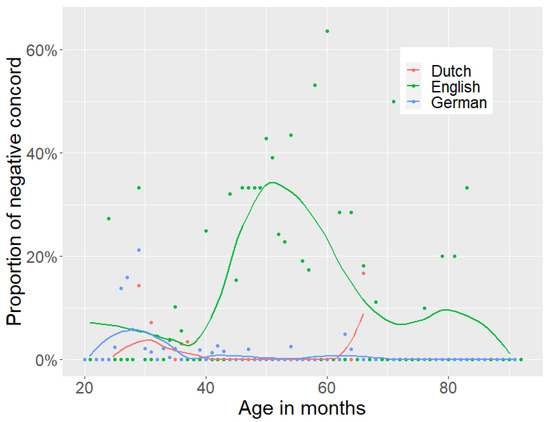
Figure 1.
Proportion of NC over age in Dutch, English and German.
As is evident, Dutch negative concord errors show a distribution very similar to the German ones: there is an early peak of about 5% around 30 months before the children hardly make any mistakes anymore. In contrast, English-acquiring children show a much higher peak of almost 40% at a much higher age of ca. 55 months. For a more detailed discussion of the German and English results and a potential explanation for the quantitative and distributional differences between them (which could possibly be extended to Dutch) we refer the reader to Hein et al. (2023).
Although Hein et al. (2023) checked for occurrences of negative concord in the recorded speech of all children’s care-givers (leading to the exclusion of Sarah from the Brown corpus) it is still possible, as they note in a footnote, that children could have had NC input from their peers and other non-recorded speakers. In fact, when one looks at the children individually, one finds that for English a single child, Adam from the Brown corpus, is responsible for 131 (71.2%) out of a total of 184 NC utterances despite only contributing 13.9% (45,573) of all utterances and 26.7% (243) of all utterances with a NI. The special status of this child has been highlighted in previous work (see e.g., Robinson 2022, p. 62, fn. 3; Thornton and Tesan 2013, p. 398, fn. 28). Adam is African-American but the notes on CHILDES explicitly state that he was acquiring Standard American English rather than African American English which shows regular NC. In addition, there is no evidence of NC in the recorded speech of his care-givers. Nonetheless, it seems possible that he was exposed to a considerable amount of NC by interlocutors other than his parents. Indeed, when we exclude Adam’s utterances the English NC distribution changes quite drastically. First, the overall error rate drops from 20.2% to a much lower 8.0%. Second, the distribution of NC errors across age now shows two clearly distinct phases rather than a single peak (Figure 2). The first phase coincides in both size (7.1%) and timing (∼26 months) with German (5.9% at ∼28 months) and Dutch (3.7% at ∼31 months). The second phase starts around 45 months and reaches error rates of up to 13.8% (at 63 months) while also carrying on for a longer duration than the first one. This suggests that whatever the cause for the initial difficulty is in German and Dutch, it might also be present for English-acquiring children. The second error peak in English indicates that there is a further issue in the acquisition of NIs specific to English. Following Hein et al. (2023), we speculate that this is due to the richer and more regularized system of NPIs in English (compared to Dutch and German), combined with the fact that children have to figure out the different licensing conditions of NIs and NPIs, which compete with each other, at least in object position (cf. Davidson 2020; Illingworth et al. 2022).
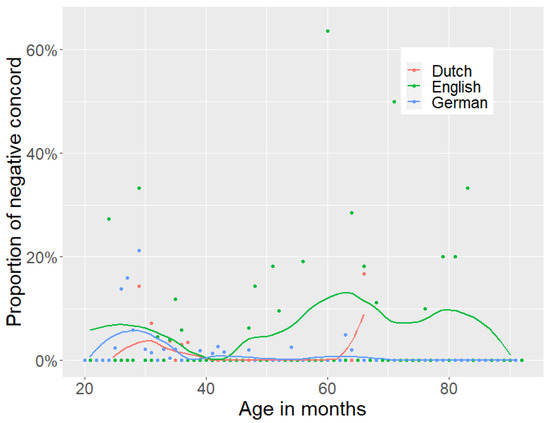
Figure 2.
Proportion of NC over age in Dutch, English (excluding Adam) and German.
Table 1 summarizes the relevant findings of Hein et al.’s (2023) study on English (enriched with our modifications concerning Adam) and German and those of our extension to Dutch.

Table 1.
Counts of different utterances.
Important for the purposes of this paper is that although the majority of children’s NI utterances are correct, the results clearly show that children acquiring these non-NC languages produce a number of NC utterances. However, they also exhibit a striking disparity between English on the one side, where about a fifth (including Adam) or a twelfth (excluding Adam) of all NI utterances show NC, and German and Dutch on the other, where this fraction drops to a fiftieth or even a hundredth. Moreover, the proportion of errors is not distributed equally across the observed age range. All three languages show a phase around 30 months where the error proportion peaks at around 5% before it drops to almost 0 at around 40 months. While it stays low for German and Dutch it rises again in English and only subsides around 90 months. One might wonder whether such low error rates should be simply dismissed as a superficial production error (i.e., ‘noise’). In response to this, we would note that the use of corpus-based spontaneous speech data has been argued to result in an underestimation of the error count (e.g., Maratsos 2000; Tomasello and Stahl 2004), meaning that the actual error rates may be expected to peak higher than in Table 1. Moreover, we would note that, while rates of commission errors (as opposed to omission errors) in spontaneous speech of children have been found to be generally quite low (cf. Snyder 2007), they have, nonetheless, been used to draw conclusions about children’s linguistic knowledge and grammatical models in other domains (see e.g., Sauerland et al. 2023 for antonyms; Rowland 2007; Rowland et al. 2005 for questions, Pinker and Ullman 2002 for overregularizations; Hein et al. 2022; Suh et al. 2013 for comparatives). We therefore take it, that errors at such rates can also be informative in the domain of negation, and so, we think that an account of NIs and NC should ideally be able to capture such NC errors made by children. As we discuss in Section 4.3, in the account that we are pursuing in this paper, children’s errors result from an inconsistent ordering of rules. The overall difference between English and the other languages results from the fact that the target English grammar slightly diverges from that of German, Dutch and other non-NC languages in having generally a partial rather than total rule ordering.
Another notable asymmetry emerges between comprehension and production. As the results from the comprehension experiments by Thornton et al. (2016) and Nicolae and Yatsushiro (2022) show, children assigned a NC interpretation to utterances with a negative marker and a NI in about 80–90% of the cases, whereas the corpus data reported here and in Hein et al. (2023) show that they actively produce NC utterances in only up to 13% of cases at a given age. We suggest that this difference might be caused by additional factors besides a non-target grammar that amplify the amount of NC in comprehension.6 For example, as double negation readings arguably come with a higher processing load (cf. Corblin 1996; Déprez et al. 2015; Jou 1988; Zhou et al. 2014) children might simply ignore extra negations in comprehension on account of their limited processing capabilities.7 Moreover, DN readings are restricted to appropriate contexts (cf. Nicolae and Yatsushiro 2022; Puskás 2012) which required the test sentences to be pragmatically quite complex. As children are known to be less sensitive to pragmatics (e.g., Chien and Wexler 1990; Grodzinsky and Reinhart 1993; Reinhart 2006), Thornton et al. (2016, p. 25) point out, that this might have led to a greater amount of NC responses. In addition, DN readings come with a specific prosody (cf. Nicolae and Yatsushiro 2022; Pilar et al. 2015). Given that children are not sensitive to prosodic cues to a speaker’s intended meaning (see e.g., Gualmini et al. 2003; Speer and Ito 2009) they might have missed the DN interpretation and assigned the single negation one instead by treating the doubled negation as the speaker’s mistake. In total, these factors may have contributed to the observed strong preference for assigning single negation interpretations, i.e., NC readings, over double negation readings. These factors, however, only apply to comprehension where the child has to map a meaning to a given input sentence containing two negative elements. In production, where the child aims to convey a single negation reading, but still produces two negative elements, she should neither have to process two semantic negations nor deal with the complex pragmatics of double negation interpretations. Moreover, while children struggle to make use of prosodic input, they seem to be as proficient as adults in producing sentences with proper prosody (Cutler and Swinney 1987; Hornby and Hass 1970; MacWhinney and Bates 1978; Wells et al. 2004). As a result, children may have experienced fewer difficulties producing negative sentences in an adult-like manner. Taken together, these considerations are one way to account for the different magnitude of NC results between comprehension and production.
We interpret the overall results of these various studies as showing that children acquiring a non-NC language go through a phase during acquisition where their grammar allows for the generation of NC sentences. As NC constitutes an error in this type of language but is completely grammatical in another, theories covering NC and NIs should be able to account for both the typological variation of the phenomenon in adult languages and the errors that children make during acquisition. In the following sections of this paper, we will present the predominant existing NC theories, based on Agree or movement, and explore how they fare with regard to these two criteria. As will become clear, all of them face challenges with one or the other. In response, we will develop a distinct analysis based on the interaction of morphological rules operating on a semantic input structure within (a version of) the Meaning First framework.
3. Syntactic Theories of Negative Concord and Negative Indefinites
3.1. Agree-Based Accounts of Negative Concord
Due to Zeijlstra’s (2004) seminal dissertation on the topic, the prevalent view of NC in current minimalism is as an instance of (Upward) Agree. Elaborating on proposals by Brown (1999) and Weiß (2002), he argues that NCIs are, in fact, not semantically negative (Ladusaw 1992), i.e., they do not contribute a semantic negation to the sentence meaning. Instead, he proposes that they bear an uninterpretable [uNeg] feature that needs to be checked against an interpretable [iNeg] feature via Agree. In a strict NC language, only the (covert) negative operator Op may bear a [iNeg] feature. This means that the negative marker is treated like any other NCI and has a [uNeg] feature. As multiple NCIs in a sentence each bearing their own [uNeg] feature still only yield a single semantic negation, a single [iNeg] feature must be able to license several [uNeg] features. Therefore, Zeijlstra (2004) adopts Multiple Agree (Hiraiwa 2001, 2005; Ura 1996) where, within an accessible domain, features may be checked under Agree in a many-to-one relation, contrary to Chomsky (2001). In (14b) the relevant feature specifications and Agree relations (indicated throughout the paper by dashed arrows) are illustrated for the Czech example (14a), repeated from (1c).
| (14) | Strict NC language with multiple NCIs (Czech) | ||||||
| a. | Dnes | nikdo | ne-volá | nikoho. | single neg reading | ||
| today | nobody | neg-call | nobody | ||||
| ‘Today nobody calls anybody.’ | (Giannakidou and Zeijlstra 2017, p. 9) | ||||||
| b. |  | ||||||
In non-strict NC languages, in addition to the (covert) negative operator, the negative marker also bears an interpretable [iNeg] feature. NCIs in a position below the negative marker will therefore check their [uNeg] feature against the negative marker. This accounts for the single negation reading with postverbal NCIs as found in the Italian example in (15a). Again, as shown in (15b), Multiple Agree is required to account for the grammaticality of several postverbal NCIs with only one licensing negation.
| (15) | Non-strict NC language with (multiple) postverbal NCIs (Italian) | ||||||||
| a. | Maria | non | ha | detto | niente | a | nessuno. | single neg reading | |
| Maria | neg | has | said | nothing | to | nobody | |||
| ‘Maria hasn’t said anything to anybody.’ | (Penka 2011, p. 49) | ||||||||
| b. |  | ||||||||
An NCI in a position above the verb, and therefore also above the negative marker, as in the Italian example in (16), repeated from (2b), requires the presence of an even higher covert Op in order to Agree and check its [uNeg] feature. The negative marker is not available for checking in this position.
| (16) | Non-strict NC language with preverbal NCI (Italian) | ||||||
| a. | Nessuno | (*non) | ha | visto | Mario. | single neg reading | |
| nobody | neg | has | seen | Mario | |||
| ‘Nobody saw Mario.’ | (Zanuttini 1991, p. 111f.) | ||||||
| b. |  | ||||||
If present in order to license a preverbal NCI, this high operator may check the [uNeg] features of other NCIs via Multiple Agree and thereby obviate the need for an overt negative marker, as exemplified by (17), repeated from (2c).
| (17) | Non-strict NC language with pre- and postverbal NCIs (Italian) | ||||||
| a. | Nessuno | ha | detto | niente. | single neg reading | ||
| nobody | has | said | nothing | ||||
| ‘Nobody has said anything.’ | (Zanuttini 1991, p. 108) | ||||||
| b. |  | ||||||
The cooccurence of a preverbal NCI and the negative marker, which is only possible if the NCI receives prominent stress, will therefore result in a double negation reading as exemplified in (18), repeated from (4). This is because the preverbal NCI requires the presence of high Op with an interpretable Neg feature while the negative marker itself contributes a second interpretable Neg feature.
| (18) | Non-strict NC language with negative marker and preverbal NCI (Italian) | ||||||
| a. | NESSUNO | non | ha | mangiato. | double neg reading | ||
| nobody | not | has | eaten | ||||
| ‘Nobody didn’t eat’ = ‘Everybody ate.’ | (Penka 2011, p. 19) | ||||||
| b. |  | ||||||
The analysis of NIs in non-NC languages is very different from the Agree-based approach in NC languages. Specifically, NIs are treated as negative quantifiers, introducing a semantically contentful negation on their own. In later work, Zeijlstra (2011) proposes that they are syntactically and semantically complex consisting of a negative operator with an existential quantifier as its sister as shown in (19). A special spell-out rule then ensures that this complex structure is pronounced as a NI, like e.g., kein in German.
| (19) | Negative indefinite in non-NC languages (Zeijlstra 2011, p. 119) | ||||
 | |||||
The account is motivated by the fact that NIs in languages like German can introduce semantic negation on their own; the addition of a negative marker triggers double negation readings. The local decomposition of the NI into Op and ∃ is necessary, as non-NC languages display split scope readings for NIs cooccurring with modal verbs (Geurts 1996; Jacobs 1980; Penka 2007). The objects in (20) receive a de dicto reading, i.e., the indefinite takes scope under the modal. At the same time, negation takes scope above the modal.
| (20) | Split scope readings in non-NC languages | |||||||
| a. | The company need fire no employees. | (Potts 2000) | ||||||
| ⇝ It is not the case that the company is obligated to fire employees. | ||||||||
| b. | Ze | hoeven | geen | verpleegkundige | te | ontslaan. | Dutch | |
| they | need | n-indef | nurse | to | dismiss | |||
| ‘They don’t need to dismiss any nurse.’ | (Rullmann 1995, p. 194) | |||||||
| c. | Du | musst | keine | Krawatte | anziehen. | German | ||
| you | must | n-indef | tie | wear | ||||
| ‘It is not required that you wear a tie.’ | (Penka 2007, p. 270) | |||||||
The split scope facts have been taken as evidence that NIs have to be decomposed into a sentential neg operator and an existential (Jacobs 1980; Penka 2011; Sauerland 2000), along the lines of NC languages. Zeijlstra (2011), however, argues that non-NC languages like German, Dutch, and English derive split scope readings via QR (21a) and partial copy interpretation (Abels and Martí 2010). At LF, the higher copy of Op and the lower copy of the existential are interpreted, allowing other elements like modals to take scope in between the two (21b). At PF, only the lower copy is pronounced (21c). Hence, the underlying structure of NIs in non-NC languages is very different from that of NCIs in NC languages. Most notably, Agree does not play a role.
| (21) | Spell-out and interpretation of NIs in non-NC languages | ||
| a. |  | step 1: QR | |
| b. |  | step 2: LF | |
| c. |  | step 2: PF | |
With the analysis of NC and non-NC languages in place, we can now address the pattern found in English dialects. Tubau (2016) proposes an extension of the Agree-based account for dialects of British English. Recall from Section 1 that dialects of English allow for the NC pattern as well as the non-NC pattern. Tubau proposes that NIs in British English dialects can come with either a [iNeg] or a [uNeg] feature. In the former case, a non-NC pattern emerges (22a), in the latter case an NC pattern is derived (22b). Each [iNeg] introduces semantic negation.
| (22) | British English dialects (cf. Tubau 2016, pp. 159–60) | ||
| a. | I saw nobody[iNeg]. | ||
| b. |  | single neg reading | |
Although not discussed by Tubau, the analysis in (22) can also derive a double negation reading for a surface structure identical to (22b), in case the negative marker is combined with the [iNeg] version of nobody. Hence, the surface string I didn’t see nobody is ambiguous between single and double negation readings. For split scope readings, Tubau (2016, p. 157, fn. 13) follows Zeijlstra (2011) in analysing them as a result of QR and partial copy interpretation.
In contrast to Zeijlstra (2004, 2011), Penka (2007, 2011) attempts to unify the treatment of NCIs in NC languages and NIs in non-NC languages under a single Agree-based approach, arguing that they are actually the same kind of element. Driven by the split scope data shown in (20), she argues that non-NC grammars display underlyingly what NC grammars mark on the surface, that is the decomposition of NIs into a negative operator, potentially scoping above a modal, and an indefinite in argument position. For NC languages, she follows Zeijlstra (2004) in most of its assumptions: (i) NCIs carry an uninterpretable Neg-feature that needs to be checked against the interpretable Neg-feature of either the abstract negative operator (for all NCIs in strict NC languages and preverbal NCIs in non-strict NC languages) or the negative marker (for postverbal NCIs in non-strict NC languages), and (ii) all NC languages allow for Multiple Agree. For non-NC languages, Penka (2007, 2011) proposes that NIs are indefinites carrying a [uNeg] feature, just like NCIs in NC languages, but that the licenser with the interpretable Neg-feature is always covert. Crucially, Multiple Agree is not available. This explains why each NI contributes its own negation. As each [iNeg] feature may only check a single [uNeg] feature, each NI bearing a [uNeg] feature requires its own licensing negative operator to check that feature (23).
| (23) | Non-NC language with multiple NIs (German) | |||||||
| a. | … | dass | niemand | kein | Auto | hat. | double neg reading | |
| that | nobody | no | car | has | ||||
| ‘… that nobody has no car.’ (Everybody has a car) | (Penka 2007, p. 277) | |||||||
| b. |  | |||||||
Since the negative marker also bears an [iNeg] feature in non-NC languages, one would—all else being equal—expect it to be able to license a NI’s [uNeg] feature similar to the abstract negative operator. A sentence with a negative marker and a NI should thus have a single negation reading because [uNeg] is checked by the negative marker’s [iNeg]. However, only the double negation reading is available. In order to force the presence of a covert negative operator with a NI, Penka (2007, 2011) suggests that Neg-feature licensing is also sensitive to whether the licenser is overt or covert. To achieve this, she introduces a second pair of features, namely [uNeg⌀] and [iNeg⌀], with the restriction that only [iNeg⌀] may check [uNeg⌀] and only [iNeg] may check [uNeg]. The obligatory double negation reading with a sentence such as (24), repeated from (5b) is thus accounted for.
| (24) | Non-NC language with negative marker and NI (German) | ||||||||
| a. | … | dass | ich | nicht | nichts | gegessen | habe. | double neg reading | |
| that | I | not | nothing | eaten | have | ||||
| ‘… that I didn’t eat nothing.’ = ‘… that I ate something.’ | (Penka 2011, p. 107) | ||||||||
| b. |  | ||||||||
The claim, then, is that NIs in non-NC languages all bear the ⌀-version of the Neg-feature as does the abstract negative operator Op¬[iNeg⌀], whereas the negative marker carries a plain [iNeg] feature and is, therefore, unable to license NIs.
In summary, the distribution of the different types of Neg-features across the different elements involved in the Agree relations in different types of languages is given in Table 2.

Table 2.
Make-up of different language types in Penka (2007, 2011).
The third and most recent Agree-analysis of NC is presented in Deal (2022b). She argues (contra Polinsky and Preminger 2019; Preminger 2013; Preminger and Polinsky 2015; Zeijlstra 2004, et seq.) that an Agree-based approach to NC does not necessarily require Upward Agree. Instead, if one adopts the conception of Agree in Deal (2015) that distinguishes Interaction from Satisfaction features, a Downward Agree implementation of NC is readily available. The need for Upward Agree in the previous analyses arose from the fact that the NCIs, by virtue of bearing the uninterpretable version of the Neg-feature, were acting as probes looking for an interpretable [iNeg] to check their Neg-feature. This semantics-based distinction between interpretable (or valued) and uninterpretable (or unvalued) features is done away within the Interaction and Satisfaction theory of Agree (Deal 2015, 2022a). Instead, a probe is specified for features that it interacts with, i.e., copies onto itself, and for features that satisfy it, i.e., halt the search for further goals. Multiple Agree follows naturally from this system if no satisfying feature intervenes between two goals. Severing the link between (un)interpretability and probehood allows Deal to specify the negative marker (or the abstract negative operator) as the probe. NIs generally bear a feature [nw] (presumably mnemonic for neg-word). For a non-strict NC language like Italian, she assumes that the negative marker is specified to interact with this feature, indicated by [int:nw], thereby licensing the special NCI morphology on a postverbal NCI. As the satisfaction feature is left unspecified, Agree does not halt until every potential goal within the Agree domain has been interacted with, essentially equivalent to Multiple Agree. This accounts for the single negation reading with several postverbal NCIs as in (25), repeated from (15a).
| (25) | Non-strict NC language with (multiple) postverbal NCIs (Italian) | ||||||||
| a. | Maria | non | ha | detto | niente | a | nessuno. | single neg reading | |
| Maria | neg | has | said | nothing | to | nobody | |||
| ‘Maria hasn’t said anything to anybody.’ | (Penka 2011, p. 49) | ||||||||
| b. |  | ||||||||
For preverbal NCIs, Deal follows Zeijlstra and Penka in postulating a covert negation operator that bears the same feature specification as the negative marker, i.e., [int:nw, sat:–].
| (26) | Non-strict NC language with preverbal NCI (Italian) | |||||
| a. | Nessuno | ha | visto | Mario. | single neg reading | |
| nobody | has | seen | Mario | |||
| ‘Nobody saw Mario.’ | (Zanuttini 1991, p. 111f.) | |||||
| b. |  | |||||
Although not explicitly discussed in Deal (2022b), her approach carries over to strict NC languages like Czech, if, in line with Zeijlstra (2004), one assumes the negative marker acts like an NCI in also bearing [nw]. For strict NC languages, too, the probes are insatiable ([sat:–]), that is, they interact with all goals in their respective domain giving the effect of Multiple Agree. This is shown in (27), repeated from (1c).
| (27) | Strict NC language with multiple NCIs (Czech) | |||||
| a. | Dnes | nikdo | ne-volá | nikoho. | single neg reading | |
| today | nobody | neg-call | nobody | |||
| ‘Today nobody calls anybody.’ | (Giannakidou and Zeijlstra 2017, p. 9) | |||||
| b. |  | |||||
Once a probe’s satisfying feature is set to [nw], only a single NCI may be licensed by it. This is exploited in the analysis of French provided in Deal (2022b). Without further ado, it can be transferred to non-NC languages by assuming that NIs are equipped with a [nw] feature, just like NCIs in NC languages. In contrast to NC languages, however, the negative marker is not specified, neither as a probe nor as a goal. Instead, it is the abstract negative operator which is solely responsible for licensing; it carries the features [int:nw, sat:nw]. This set-up gives rise to a system in which every NI requires its own local licensing negative operator similar to Penka’s Upward Agree proposal, albeit without the need to distinguish two features. Thus, the double negation reading of a sentence with two NIs is accounted for, as shown in (28), repeated from (5a).
| (28) | Non-NC language with multiple NIs (German) | |||||||
| a. | … | dass | niemand | kein | Auto | hat. | double neg reading | |
| that | nobody | no | car | has | ||||
| ‘… that nobody has no car.’ (Everybody has a car) | (Penka 2007, p. 277) | |||||||
| b. |  | |||||||
| c. |  | |||||||
Since the negative interpretation of the negative marker is independent of its status as a probe, it is not necessarily a licenser of [nw] simply because it gives rise to a semantic negation. Hence, a sentence with a negative marker and a NI such as (29), repeated from (5b), obtains a double negation reading because the negative marker is semantically negative but syntactically inactive (for Agree). The NI therefore requires a covert licenser in the form of the negative operator, which introduces a second semantic negation.
| (29) | Non-NC language with negative marker and NI (German) | ||||||||
| a. | … | dass | ich | nicht | nichts | gegessen | habe. | double neg reading | |
| that | I | not | nothing | eaten | have | ||||
| ‘… that I didn’t eat nothing.’ = ‘… that I ate something.’ | (Penka 2011, p. 107) | ||||||||
| b. |  | ||||||||
The feature specifications of the different elements involved in negation and NC in different types of languages is given in Table 3. A comparison to Table 2 reveals that both Deal’s and Penka’s account assume the same underlying decomposition of NIs for NC and non-NC languages, thereby ensuring that modals can scope in between an abstract negative operator and the indefinite, as was shown in (20).

Table 3.
Make-up of different language types in Deal (2022b).
In this section, we briefly summarized the Agree-based accounts of NC and NIs. In the next section, we will address empirical and conceptual problems pertaining to these Agree-based approaches.
3.2. Problems with Agree-Based Accounts of Negative Concord
Virtually all Agree-based accounts of NC face three empirical shortcomings. The first problem concerns the obligatory presence of the negative marker in strict NC grammars. Here is how Penka (2020, p. 20) phrases the problem:
Recall the analyses for strict NC grammars, repeated in (30), based on data from the strict NC language BCS. Since a covert negation operator is the only possible licenser and the negative marker comes with a [uNeg]/[nw] feature, what forces the latter’s presence?“In many languages, negative indefinites have to co-occur with the negative marker, even though the negative marker does not seem to make any semantic contribution. This is the case in strict negative concord languages, in particular, where the negative marker is often assumed to be semantically vacuous, even though the negative marker has to be included for a negative sentence to be grammatical.”
| (30) | Obligatory negative marker in strict NC language (BCS) | |||||
| a. | Milan | *(ne) | vidi | ništa. | (Progovac 1994, p. 40) | |
| Milan | not | sees | nothing | |||
| ‘Milan doesn’t see anything.’ | ||||||
| b. |  | (Penka 2011; Zeijlstra 2004) | ||||
| c. |  | (Deal 2022b) | ||||
One could reasonably argue that a negated sentence must contain some overt expression of that negation (as ensured by the faithfulness constraint FNeg in de Swart’s (2010) Optimality-Theoretic implementation of NC). However, why does the negative marker then still have to occur in sentences where negation is already expressed by another NCI, like ništa in (30)?
The second problem concerns the ban of positive indefinites in negative utterances of NC grammars and non-NC grammars—again, an issue Penka (2020, p. 20) already identifies:
We illustrate this problem with BCS in (31), where it can be observed that the members of the pair nitko-netko ‘nobody-somebody’ are in complementary distribution. In the scope of negation, nitko must be used (31a). The positive indefinite netko obligatorily receives a wide scope reading (31b).“Converse to the observation that the negative marker is obligatory, there is the fact that negative indefinites are often the only indefinites that can be used in the scope of negation, to the exclusion of NPIs and general indefinites.”
| (31) | No positive indefinite in the scope of negation in NC language (BCS) | |||||
| a. | Nitko | ne | vidi | Milan-a. | (Progovac 1994, p. 40) | |
| nobody | not | sees | Milan-acc | |||
| ‘Nobody sees Milan.’ | ||||||
| b. | Milan | nije | uvredio | netko-ga. | (Progovac 1994, p. 43–44) | |
| Milan | not-is | insulted | someone-acc | |||
| ‘Milan has not insulted someone.’ | ||||||
| It is not the case that Milan insulted a person. | ||||||
| ⇝ There is a person X such that Milan did not insult X. | ||||||
The polarity nature of positive indefinites like netko is not predicted by Agree-based accounts of NC. While the [uNeg] feature on an NCI essentially restricts the NCI’s occurrence to below a licensing negation, nothing prevents the respective general indefinite (that does not bear a [uNeg] feature) from appearing in the same position, i.e., below negation.8 Similar observations can be made for a non-NC language like German, shown in (32). The NIs niemand and kein are clearly preferred over their positive counterparts.
| (32) | No positive indefinite in the scope of negation in non-NC language (German) | |||||||
| a. | Emma | hat | niemanden / ??{ | nicht | jemanden} | beleidigt. | ||
| Emma | has | nobody | not | somebody | insulted | |||
| ‘Emma insulted nobody.’ | ||||||||
| b. | Emma | hat | keinen / ??{ | nicht | einen} | Apfel | gegessen. | |
| Emma | has | no | not | a | apple | eaten | ||
| ‘Emma did not eat an apple.’ | ||||||||
The third empirical challenge all Agree-accounts face is the seemingly universal cross-linguistic restriction of NC to indefinite determiners and pronouns. Definite determiners for example are to our knowledge not reported to engage in NC. Yet nothing prevents a language under the Agree-based analysis to equip definite determiners with a [uNeg] or [nw] feature. In other words, there is nothing intrinsically blocking the co-occurrence of a [uNeg]/[nw] feature and a [+def] feature on a D head. It rather looks as if the answer to this cross-linguistic restriction must be found in the underlying semantic structure of negative utterances containing indefinite arguments, as opposed to definite arguments. Hence, a purely syntactic account of NC seems undesirable.
Beyond the empirical shortcomings, Agree accounts face a number of conceptual challenges, as they all come with an enriched technical machinery to account for the cross-linguistic patterns. For the remainder of this section, we will discuss each account introduced in the previous section in turn. Zeijlstra’s account of NC requires two extensions of Agree: (i) Upward Agree, and (ii) Multiple Agree. Upward Agree is necessary because the interpretable [iNeg] feature is usually located in a higher position than the uninterpretable [uNeg] features which as probes initiate the Agree relation (i.e., start the search for a matching interpretable feature). While Upward Agree has been argued to be an option besides (standard) Downward Agree (or even the only option for Agree, Bjorkman and Zeijlstra 2019; Zeijlstra 2004, 2012) and to be necessary for—or at least compatible with—agreement phenomena in other domains (sequence of tense, Zeijlstra 2012; (strict) NPI licensing, Chierchia 2013; den Dikken 2006; binding, Hicks 2009; Reuland 2006; semantic agreement, Smith 2015; inflection doubling, Bjorkman 2016; Wurmbrand 2012, 2014), NC arguably still provides the strongest argument for its adoption. We believe that even the implementation of NC as Downward Agree in Deal (2022b) ultimately requires at least some Upward directionality.9 The argument for Upward Agree, however, only holds under a treatment of negative concord as agreement. As there are approaches to negative concord without Agree (e.g., de Swart 2010; de Swart and Sag 2002; Herburger 2001; Kuhn 2022), we believe that non-trivial extensions to the syntactic Agree mechanism introduced mainly to account for a single empirical phenomenon are a drawback and should be avoided (see also Bárány and van der Wal 2022; Polinsky and Preminger 2019; Preminger 2013; Preminger and Polinsky 2015 for arguments against Upward Agree).
Penka’s approach suffers from similar conceptual drawbacks. First, as it generally builds upon Zeijlstra’s (2004) Agree-based analysis, the criticism of Multiple Agree and Upward Agree as non-trivial extensions of Agree levelled at the latter also holds here. Second, the distinction between [Neg] and [Neg⌀] is dubious. Although their labels give the impression that we are dealing with just two versions of the same feature, from a syntactic point of view they are two distinct entities. Nonetheless, their semantic effect, namely encoding a negation, is the same, which seems redundant. The problem with those features is the following: What Penka actually tries to encode by them is that successful checking in a syntactic Agree relation is dependent on the morphological form of the goal. This is tantamount to stating that the probe (i.e., a NCI) only agrees with a [iNeg]-carrying goal, if that goal is phonologically empty. As this is an instance of phonology guiding a syntactic derivation, it violates the Principle of Phonology-Free Syntax (Miller et al. 1997; Zwicky 1969; Zwicky and Pullum 1986). It further indicates that a purely syntactic treatment of NC and NIs might be on the wrong track and that the observed dependencies might better fall out from an approach that is framed in morphological terms, such as the approach we present in Section 4.
The final NC account we investigated was based on the Interaction and Satisfaction theory of Agree (Deal 2015, 2022a). Though Deal’s proposal is able to elegantly integrate Multiple Agree as a theorem, it still constitutes a renunciation of the canonical Agree mechanism by introducing Interaction and Satisfaction. Moreover, its abandonment of Upward Agree by decoupling (un)interpretability and probehood might not be as complete as it seems, at least in the domain of NC (see Note 9).
3.3. An Alternative to Agree: The Movement-Plus-Allomorphy Account
Before we move on to discuss how the accounts fare with respect to the child production data, let us briefly address an alternative to the Agree-accounts of NC, one that makes use of the copy theory of movement and was specifically developed for English and its varieties. Since we discuss at length the extensions to which the Agree-based accounts commit, it is worth discussing an account of NC that dispenses with an explanation based on Agree relations altogether.
Based on the work on NPI licensing in Collins and Postal (2014), Blanchette (2015) develops an extension to NC in English. Indeed, Blanchette argues that English instantiates a NC grammar, based on a series of experiments (Blanchette and Lukyanenko 2019a, 2019b; Blanchette 2017) which show that speakers of Standard English allow for single negation readings of utterances such as Maria didn’t drive no cars, alongside double negation readings. Consequently, NC utterances are attributed the same underlying syntax as their NPI containing equivalents, i.e., Maria didn’t drive any cars. While both variants are freely used in English vernaculars (shown for Appalachian English by Blanchette 2015 and for UK-based dialects by Tubau 2016), the NC variant in Standard English is suppressed due to the social stigma. Robinson and Thoms (2021) adopt Blanchette’s proposal and develop it further (mainly to account for the lack of NPI subjects). The derivations of the NPI and the NC variant are shown in (33a) and (33b). Assuming with Collins and Postal (2014) that negated indefinites enter the derivation already containing a neg part, both structures are derived from raising neg from the indefinite to its surface position, where it is spelled out as n’t. The lower copy of this movement chain is spelled out as no/any, in Blanchette’s theory as some form of resumption, and in Robinson and Thoms’ theory as some form of socially conditioned allomorphy. The non-NC variant, shown in (33c), does not involve movement.10 All three variants have single negation readings since only one neg component is introduced. The surface structure Maria didn’t drive no cars, however, can also receive a double negation reading, as shown in (33d) where two seperate neg components are introduced.
| (33) | English as an NC grammar (cf. Blanchette and Lukyanenko 2019a, pp. 5–6) | |
| a. |  | |
| b. |  | |
| c. | Maria drove no cars: Maria drove [DP [D neg some] cars] | |
| d. | Maria didn’t drive no cars: Maria didneg2 drive [DP [D neg1 some] cars] | |
Since this alternative approach is developed for English (dialects), where variation exists both on the form level and on the meaning level, some adjustments have to be made to extend the analysis to NC grammars of the Slavic type which are notably more restricted. Recall from (30) that NC grammars like BCS block non-NC patterns like (33c). One way of modeling the typological difference is by assuming that the neg component obligatorily raises in NC grammars. This could potentially also block the double negation readings of NC patterns, derived by (33d). This is a welcome result because, as mentioned in Section 1, double negation readings of the type in (33d) are commonly excluded in NC grammars. With this assumption in place, the movement account is superior to Agree-based accounts with respect to the obligatory presence of a negative marker in NC languages, as it simply falls out from the modeling of the typological difference between English varieties and NC grammars. The restriction to indefinites is possibly also derived by this account, as the existence of NC is tied to the presence of negative existential quantifiers in the clause. However, the movement account faces challenges when accounting for multiple NCIs in NC grammars. Take the example in (15), repeated here as (34) with the Agree analysis presented in (34b). Based on the discussion so far, the movement analysis would have to be sketched as in (34c).
| (34) | Multiple NCIs in NC grammar (Italian) | ||||||||
| a. | Maria | non | ha | detto | niente | a | nessuno. | single neg reading | |
| Maria | neg | has | said | nothing | to | nobody | |||
| ‘Maria hasn’t said anything to anybody.’ | (Penka 2011, p. 49) | ||||||||
| b. |  | ||||||||
| c. |  | ||||||||
Under Blanchette’s (2015) account, something additional has to be said so that the negative marker is not spelled out twice, which is contrary to what the surface structure shows. Robinson and Thoms’ (2021) modification of Blanchette’s movement account has a better handle on such data, as they argue that the neg component is always an abstract negative operator which is attracted to the specifier of a P polarity phrase. Moreover, they suggest that what is spelled out as the negative marker is, in fact, the head of P in the context of a filled specifier (Robinson and Thoms 2021, p. 201). In any case, neither account seems to be able to derive the single negation reading of (34) since each NCI introduces its own neg component.11
We can also ask whether movement accounts fare better than Agree accounts with respect to the empirical observation that positive indefinites are often blocked from appearing in the scope of negation, as was shown in (31) and (32). Without additional assumptions, the movement approach does not derive this observation. The assumption that a neg component can enter the derivation as part of an indefinite does not preclude derivations where indefinites are merged without a neg component. In fact, they have to be able to do so when they appear in positive statements. Whether there is a neg component merged higher in the tree is orthogonal to the decomposition of the indefinite.12
3.4. Accounting for Children’s Productions of Negative Concord
In addition to covering the typological variation, approaches to NC and NIs should be able to account for the fact that children acquiring non-NC languages produce NC utterances during acquisition. In this section, we will briefly review how, for each of the syntactic approaches just presented, children are proposed to acquire the negative system of their target language and, in particular, how these proposals might make sense of the noted errors children make.
In acquisition, the child is, broadly speaking, faced with the task of determining whether she is acquiring a NC language (strict or non-strict) or a non-NC language. For Zeijlstra (2004), this distinction is tied to the phrase structural status of negation in a language. If negation is an adverb, i.e., phrasal, the language shows no NC and only has a semantic negation feature [Neg]. If, however, negation is a head, then the language allows NC. This is because a (negative) head must be able to project (a NegP) and only syntactic features (not semantic or phonological ones) can be projected (Zeijlstra 2007). Thus, the Neg feature on a negative marker head must be a syntactic feature taking the form [i/uNeg] and can therefore, in principle, enter into Agree relations with other elements that bear [u/iNeg]. Zeijlstra argues that language learners initially adopt semantic negation for reasons of economy, i.e., it does not require the construction of a NegP. Only if there is (enough) positive evidence in the input does a learner postulate a NegP. The presence of multiple negative forms with only a single negation interpretation as found in NC languages constitutes clear evidence of the underlying Agree relation between syntactic negation features [iNeg] and [uNeg]. Therefore, learners of a NC language will relatively quickly transition from semantic negation to formal syntactic negation features. For learners of a non-NC language there is no reason to make this transition as their input is consistent with the initial grammar where each negatively marked element carries a semantic negation.
Thornton and Tesan (2013) show how this model of acquisition may account for the production of NC utterances by children, at least those who are acquiring English. While overt doubling effects in NC may constitute the clearest and most easily detectable evidence for a negation head, it may also be signalled by other head-specific properties, such as the possibility of undergoing head movement. Thus, children who are acquiring standard English, while having no or only little NC input, will nonetheless postulate a Neg head (realized by n’t) based on alternative evidence. This evidence arguably encompasses questions with raised negative auxiliaries (I-to-C head movement), negative tags, and possibly more (Thornton and Tesan 2013). Once they have postulated a Neg head and thereby also formal negation features, NC becomes possible in principle.
While this reasoning potentially explains the NC productions of English-speaking children, it fails to capture those of the Dutch- and German-speaking kids. That is, Dutch and German only have adverbial negation and there is no evidence whatsoever for a learner to posit a Neg head in those languages. In addition, it leaves unexplained why NC involves NIs at all. As pointed out in Section 3.1, Zeijlstra’s (2004; 2011) treatment of NIs is very different from his analysis of NCIs, in particular, they do not carry a syntactic negation feature. Instead, they are taken to be negative existential quantifiers and should therefore never be able to interact with the NC system. But even if they bore a syntactic negative feature, one would expect them to bear [iNeg], as the input contains ample evidence that they can negate a proposition on their own, i.e., without the need for a licensing negation.
In any case, let us accept for a moment that children actually posit a [iNeg] feature on NIs and, as Thornton and Tesan (2013, p. 385) seem to assume, take the negation head to carry [uNeg] (which is usually checked against a covert operator’s [iNeg] feature located in Neg head’s specifier). One might imagine that the Neg head could exceptionally check its [uNeg] feature against the NI’s [iNeg] feature, voiding the need for the covert operator in SpecNegP. However, while this hypothetical state of circumstances can capture NC utterances involving a single NI, it leads to the expectation that utterances with sentential negation and two NIs have double negation readings. This is due to each NI contributing its own [iNeg] feature which triggers semantic negation. There are two such utterances in the English corpora (35) and both have a single negation reading. However, they might not bear on the issue as Adam might well have been acquiring a NC dialect (cf. Section 2.2).
| (35) | a. | I can’t do nothing with no string. | (Adam 4;02, Brown 1973) |
| b. | She didn’t use no nothing of paper. | (Adam 4;05, Brown 1973) |
If one adopts Zeijlstra’s (2011) view of NIs as negative existential quantifiers, as detailed in (21), one could potentially derive the NC-type errors if one assumed that for some reason children delete only the ∃-Object part of the higher copy of [Op-∃-Object] at PF and spell out Op as the negative marker as in (36a). However, once we allow for this type of scattered copy deletion at PF, we would also expect children to sometimes delete just the Op part, as in (36b), and produce something like (37a), or fail to delete anything in the higher copy, as in (36c), and thus produce a copy of the NI, as shown in (37b).
| (36) | Potential mistakes with scattered deletion by children | ||
| a. |  | step 2: PF | |
| b. |  | step 2: PF | |
| c. | [Op-∃-Object] Subject Verb [Op-∃-Object] | step 2: PF | |
| (37) | Unattested errors | |
| a. | *Something Peter saw nothing. | |
| b. | *Nothing Peter saw nothing. | |
No such utterances were reported in the corpus studies surveyed in Section 2, despite the fact that the search procedure in Hein et al. (2023) would have returned them. Although one cannot draw strong conclusions from the absence of an utterance from a corpus, we take it as suggestive that an explanation for the attested errors as erroneous scattered deletion in the higher copy of a negative quantifier might be on the wrong track.
As for the other two Agree-based accounts, Penka (2007, 2011, 2020) and Deal (2022b), they do not mention how acquisition of their systems proceeds or how erroneous NC utterances by children might be accounted for. Therefore, they will not be discussed here.
The movement accounts of Blanchette (2015) and Robinson and Thoms (2021), on the other hand, which were developed specifically to allow for NC in English, provide a straightforward way to handle children’s NC utterances, at least in English. Specifically, as NC utterances do not constitute errors under their view, they are captured in the exact same way as the adult NC variants in (33a). The arguably higher proportion of NC utterances for Standard English-acquiring children compared to that of their parents (cf. Miller 2012 on Sarah; Thornton et al. 2016 on Adam) is attributed to them not being as sensitive to the social stigma of NC as adults yet. However, as already pointed out in Section 3.3, all else being equal, the movement account does not capture NC utterances with more than one NI, which are also found in children’s spontaneous speech (35). In addition, whether, and if so how, this approach could be extended to German or Dutch, which clearly do not allow NC underlyingly (and also lack English-type NPIs, cf. 33b), or the German/Dutch-speaking children’s errors, is an open question.
Taken together, neither the Agree-based syntactic approach to NC and NIs nor the movement-plus-allomorphy account provide a satisfying analysis of the NC utterances that are produced by children who are acquiring a non-NC language. While there are some proposals for how to deal with those errors in English, they leave the Dutch- and German-speaking children’s errors entirely unexplained.
4. It’s All in the Morphology
As the previous section revealed, there is a strong tendency in the recent literature to analyse NC and NIs by syntactic Agree, even though doing so requires non-trivial and possibly otherwise unjustified extensions to the traditional Agree approach (Chomsky 2000). One might wonder what motivates this tendency. Bjorkman and Zeijlstra (2019, p. 533) cite a list of properties related to NC, which they suggest argue against pure semantic approaches (de Swart and Sag 2002; Ovalle and Guerzoni 2004; Zanuttini 1991), and in favour of a syntactic analysis, of this phenomenon. This list includes clause-boundedness, sensitivity to locality effects, and the cross-linguistic variation of the phenomenon. Interestingly, these properties also naturally fall out under a pure morphological treatment of NC. One reason why this kind of account has not been proposed before (at least not in a post-syntactic model of morphology), is presumably due to the fact that the surface structures of NC interact with semantic interpretation. Given that neither the Y-model architecture in the generative model itself (Chomsky 1981, 1995; Chomsky and Lasnik 1993) nor the inclusion of a post-syntactic morphological component (Halle and Marantz 1993) (38) makes room for an explicit semantics-morphology interface, one might not expect these interaction effects, if NC was a pure morphological phenomenon.13 Y-model of grammar (Chomsky 1981, 1995; Halle and Marantz 1993)
| (38) | Y-model of grammar (Chomsky 1981, 1995; Halle and Marantz 1993) |
 |
A framework which provides such an interface, however, is the recently proposed Meaning First model (Guasti et al. 2023; Sauerland and Alexiadou 2020). In this model, the combination of primitive thought concepts (including logical operators and maximally decomposed lexical/contentful concepts/meanings) into a so-called conceptual structure precedes externalization, which is understood as a mapping of this structure to an arrangement of morphemes (so-called compression). Note that the operation that combines concepts into more complex concepts is assumed to be binary like Chomsky (1995)’s Merge (Sauerland and Alexiadou 2020, p. 3; Sauerland et al. 2023, p. 1). Therefore, the conceptual structures it generates are hierarchical structures very similar to the hierarchical structures created by Merge in standard minimalism, the difference being that the latter contain linguistic elements as leaves that are interpreted in a distinct subsequent module, while the former contains meaningful thought concepts that are compressed into linguistic representations in a distinct subsequent module. This is particularly relevant in light of the critical role that hierarchy plays in human language (for recent assessments see e.g., Brennan and Hale 2019; Greco et al. 2023).14 Importantly, the hierarchical organization allows us to make reference to constituency, thereby at least in principle allowing us to incorporate much of the insights of minimalist syntactic work into the model. Exactly how to achieve this is beyond the scope of the present paper (for some suggestions see Sauerland et al. 2023). For the purposes of this paper, we can roughly equate the conceptual structure with a hierarchical semantic representation, where each concept corresponds to an element in the semantics. In this model, meaning directly feeds the morphological component (39).
This architecture has some notable consequences. First, as meaning is computed prior to morphological realization, it is unaffected by any morphological processes. This will become important in Section 4.1, where the negation concept is duplicated in the morphology without a concomitant duplication of its negative meaning. Second, the model leaves no room for a syntactic component in the canonical sense. That is, there is no (hierarchy-altering) movement, only linearization, and no Agree, but rather morphological duplication or base-generation of the relevant features/concepts in different positions.
| (39) | Meaning First model of grammar (cf. Sauerland and Alexiadou 2020, 2021) |
 |
Despite those differences, we contend that the broader empirical asymmetries between different parts of linguistic structures are best represented as hierarchical relations. Therefore, we take it that the semantic concepts corresponding to a verb and its arguments must stand in essentially the same structural relation to each other as the verb and its arguments in standard minimalist structures do. For this reason and for better comprehensibility, we can and will continue to use minimalist labels such as V, VP, NP, DP, and v. These should be understood as a shorthand for whichever combinations of primitive semantic concepts turn out to be behind them.
In what follows, we will investigate NC and NIs from a morphological perspective within the Meaning First model, where semantics is visible to morphology and morphology can be sensitive to semantics. In doing so, we hope to overcome the challenges a syntactic Agree account faces, which were pointed out in the previous section. To model the cross-linguistic phenomenon of NC, our proposal makes use of a morphological reduplication rule of the Neg operator in the context of an indefinite. Since predictions about acquisition are an integral part of Meaning First, we can readily map out strategies how each solution accounts for the NC errors children make in acquisition.
4.1. Negative Concord as Reduplication
We will develop our main idea by comparing strict NC grammars to non-NC grammars. An extension of our proposal to non-strict NC languages will be discussed in Section 4.2. In (40), we show how single negation readings are expressed in the strict NC language Hungarian and the non-NC language Dutch. As shown in (40a), the negative marker nem in Hungarian is obligatorily present with the NCI semmit ‘nothing’ to express a single negation reading. Compare this to Dutch in (40b) where the NCI niemand ‘nobody’ is sufficient to signal negation.
| (40) | Non-NC vs. NC: single negation readings | |||||
| a. | Balázs | nem | látott | semmit. | Hungarian (strict NC) | |
| Balázs | not | saw | n-thing | |||
| ‘Balázs didn’t see anything. | (Giannakidou and Zeijlstra 2017, p. 7) | |||||
| b. | Ik | heb | niemand | gezien. | Dutch (non-NC) | |
| I | have | n-person | seen | |||
| ‘I haven’t seen anybody.’ | (van der Auwera and Van Alsenoy 2018, p. 117) | |||||
One way to capture concord phenomena, and specifically NC, is to reduplicate the neg concept in the morphological component, so that more than one exponent realises negation.15 We will attempt to develop such an approach in this section, while also attending to the problems the previous approaches had. In order to pursue a morphological account, it seems reasonable to pursue a theory where the semantic components neg and exists which make up negated indefinites are always in a local configuration independent of position or grammar. Moreover, at least negation should take scope above the propositional level to allow the split scope readings with a modal discussed in (20). One way to achieve this underlying semantic structure is by assuming that (negated) indefinites constitute choice functions, i.e., functions f that take a property as an argument and return an individual of that set (Kratzer 1998; Reinhart 1997; Winter 1997). A choice function f must be existentially bound, often assumed to happen at the sentence level. Since negated indefinites scope under negation, we assume with Reinhart (1997) and Winter (1997) that choice functions do not have to be existentially bound at the top-most level of semantic structure. Thus, we propose in this section that the semantic input for NCIs/NIs is the structure in (41).16
| (41) | (Negated) indefinites as choice functions: |
 |
The structure in (41) provides us with a way to capture the split scope data. We follow Abels and Martí (2010) in assuming that (i) the interpretation of an indefinite is split up, so that the quantificational determiner scopes high but the NP restriction is interpreted low, i.e., a choice function analysis, and (ii) the low scope existential reading of the indefinite is a case of pseudo-scope (Kratzer 1998), i.e., it is derived via binding of the world index of the restrictor NP by the modal. We briefly illustrate the analysis in (42) with example (20c) repeated from the previous section. Although the compositional details in our analysis diverge to some extent from Abels and Martí (2010),17 the resulting meaning of (42a) is the same and thus directly taken from their work, see (42c). The sentence in (42a) is predicted to be true if and only if there is no choice function that in all relevant worlds picks a tie from that you wear in . In other words, you don’t have to wear a tie in every world, i.e., the split scope reading of (42a).
| (42) | Split scope readings | ||||||
| a. | Du | musst | keine | Krawatte | anziehen. | (Penka 2007, p. 270) | |
| you | must | n-indef | tie | wear | |||
| ‘It is not required that you wear a tie.’ | |||||||
| b. | 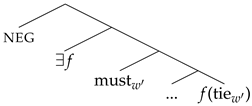 | (cf. Abels and Martí 2010, p. 440) | |||||
| c. | 〚(42a)〛 iff CF, you wear f(tie) in | ||||||
| (Abels and Martí 2010, p. 441) | |||||||
There is another benefit of the choice function analysis over the existential quantifier analysis worth discussing. As was discussed in the previous section, the Agree accounts cannot explain why NC is cross-linguistically restricted to indefinites. The account proposed in this section has at least some potential to provide an explanation. If it really is the property of high existential closure of a choice function that is responsible for reduplicating neg since it puts the existential in the vicinity of the negative operator, we predict that NC should not be possible with e.g., definite determiners since they are traditionally interpreted in their base position and not at the propositional level. Whether we predict NC with other types of quantifying determiners, however, relies on what is believed to be modeled with choice functions. One reason for why choice functions have been originally reserved for indefinites is the observation that only indefinites, but not other quantifiers, can scope out of islands. Under the assumption that QR obeys islands, exceptionally wide scope indefinites have received a choice function analysis which does not require movement. The fact that NC only occurs with indefinites can potentially be seen as another piece of evidence that a choice function analysis is specifically reserved for indefinites.
Let us now turn to the morphological realisation of the semantic structure proposed in (41). As mentioned at the beginning of this section, we propose that languages which display NCIs or NIs have a morphological rule that duplicates neg in the local context of an existential (43a). This type of rule is essentially equivalent to the enrichment rules proposed in Müller’s (2007) Distributed Morphology account of extended exponence. His enrichment rules, conceptualized as the complementary version of the more widely adopted impoverishment rules (Bonet 1991; Noyer 1992), introduce an (additional token of a) feature F on a head H in the context of F (⌀⟶ [F] / [F] ), that is, they act as feature duplication rules. While enrichment rules operate on morphosyntactic features, our duplication rule must operate on the input that the morphological component receives from the semantic/conceptual component, i.e., it must operate on semantic elements/concepts. One consequence of the Meaning First architecture is that the open bracket ‘[’ in the contextual restriction indicates immediate scope. Thus, (43a) triggers the creation of neg if neg and an existential are structurally adjacent (cf. Merchant 2015 on the locality of allomorphy triggers) such that neg scopes over the existential. Another consequence of the Meaning First architecture is that duplication of neg does not alter the semantics since the meaning of the structure has been computed prior to its transfer to morphology. As the inert semantic elements/concepts serve as the input to realisation by phonological exponents (much akin to Vocabulary Insertion in Distributed Morphology) they essentially adopt the role of the morphosyntactic features in standard realisational models of morphology. Thereby, the close resemblance bordering on identity between our duplication rule and enrichment rules is further emphasized. Moreover, our approach shows parallels with accounts of reduplication as actual doubling of a morphological constituent, such as e.g., Inkelas (2005); Inkelas and Zoll (2005). In order to derive the difference between NC and non-NC grammars, we additionally postulate that the latter have an additional morphological rule which deletes neg in the local context of an existential and neg (43b). In light of the discussion of enrichment rules, it is evident how this deletion rule is basically identical to impoverishment rules (Bonet 1991; Noyer 1992; see also Keine and Müller 2022 for a recent overview) or obliteration (Arregi and Nevins 2007, 2012) in Distributed Morphology.18
| (43) | Compressor rules / morphological rules | |
| a. | neg-duplication: ⌀⟶neg / neg [ ∃ | |
| b. | neg-deletion: neg⟶⌀ / [ neg ∃ | |
The following structures show the effect of such rules for each type of grammar. We indicate duplicates with <neg> and deleted structure with  for clarity. Vocabulary insertion is straightforward in this system, neg receives spell-out as the negative marker and neg+ as the NCI/NI. Since non-NC grammars have an additional impoverishment rule before vocabulary insertion, the negative marker is never realised in the context of an existential. Note that the addition of the <neg> duplicate does not lead to double negation readings, as neg-duplication counter-feeds semantic interpretation. This follows intrinsically from the Meaning First architecture since the morphological component is only responsible for realising the underlying semantic structure, thus no morphological rule can affect the meaning of a sentence.
for clarity. Vocabulary insertion is straightforward in this system, neg receives spell-out as the negative marker and neg+ as the NCI/NI. Since non-NC grammars have an additional impoverishment rule before vocabulary insertion, the negative marker is never realised in the context of an existential. Note that the addition of the <neg> duplicate does not lead to double negation readings, as neg-duplication counter-feeds semantic interpretation. This follows intrinsically from the Meaning First architecture since the morphological component is only responsible for realising the underlying semantic structure, thus no morphological rule can affect the meaning of a sentence.
 for clarity. Vocabulary insertion is straightforward in this system, neg receives spell-out as the negative marker and neg+ as the NCI/NI. Since non-NC grammars have an additional impoverishment rule before vocabulary insertion, the negative marker is never realised in the context of an existential. Note that the addition of the <neg> duplicate does not lead to double negation readings, as neg-duplication counter-feeds semantic interpretation. This follows intrinsically from the Meaning First architecture since the morphological component is only responsible for realising the underlying semantic structure, thus no morphological rule can affect the meaning of a sentence.
for clarity. Vocabulary insertion is straightforward in this system, neg receives spell-out as the negative marker and neg+ as the NCI/NI. Since non-NC grammars have an additional impoverishment rule before vocabulary insertion, the negative marker is never realised in the context of an existential. Note that the addition of the <neg> duplicate does not lead to double negation readings, as neg-duplication counter-feeds semantic interpretation. This follows intrinsically from the Meaning First architecture since the morphological component is only responsible for realising the underlying semantic structure, thus no morphological rule can affect the meaning of a sentence.
| (44) | a. | NC grammar:neg-duplication |
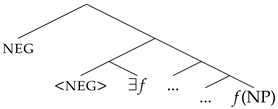 | ||
| b. | Non-NC grammar:neg-duplication ≺ neg-deletion | |
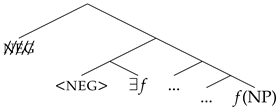 |
Before we move on to detailed derivations of the NC data, we have to address the distribution of the (negated) indefinite determiner. With nothing else being said, we predict determiners analysed by choice functions to be realised at the propositional level, away from their NP restrictors, contrary to fact. This follows from our assumption that the determiner constitutes the realisation of . Fortunately, there are ways to influence the linearization of the determiner. Given that semantic structure feeds morpho-syntax, we can formulate a rule that makes reference to semantic dependencies such as the one between and f(NP) and which determines for each language whether the head and tail of a dependency are pronounced together, and if so, whether they are pronounced at the head or the tail of the dependency. We call this rule bundling. For indefinites specifically, we propose that is always linearized adjacent to f(NP), as a result of bundling. Thus, there is a bundling rule for indefinites which enforces bundling at the tail of the dependency, as illustrated in (45), where an underscore indicates the previous position for clarity.19
We are now in a position to discuss the crucial distinctions concerning NC grammars and non-NC grammars. We use Hungarian and Dutch as representatives of each category and provide the relevant vocabulary items in (46) and (47), i.e., the negative markers in (46a)/(47a), the negative indefinites in (46b)/(47b), and the positive indefinites in (46c)/(47c).
In (48) and (49), we show how single negation readings are derived; examples are repeated for convenience. The semantic input for each grammar is the same, compare (48b) and (49b). The local configuration of neg and triggers neg-duplication. Since this rule exists in both grammars, it applies to the semantic input, see (48c) and (49c). Non-NC grammars additionally have a neg-deletion rule and (49c) provides the right locality configuration, neg-deletion applies in (49d). Finally, both grammars have a bundling rule which enforces choice function determiners to be linearized adjacent to the choice function, shown in (48d) and (49e), which eventually provide the input for vocabulary insertion.
| (45) | Bundling: |
 |
| (47) | VIs for non-NC grammar, Dutch | |
| a. | /niet/ ⇔ [neg] | |
| b. | /niets/, /niemand/ ⇔ [neg,∃] | |
| c. | /iets/, /iemand/ ⇔ [∃] | |
| (47) | VIs for NC grammar, Hungarian | |
| a. | /nem/ ⇔ [neg] | |
| b. | /semmit/, /senki/ ⇔ [neg,∃] | |
| c. | /valamit/, /valaki/ ⇔ [∃] | |
| (48) | Single negation reading in NC grammar (Hungarian) | |||||
| a. | Balázs | nem | látott | semmit. | (Giannakidou and Zeijlstra 2017, p. 7) | |
| Balázs | not | saw | n-thing | |||
| ‘Balázs didn’t see anything.’ | ||||||
| b. | Step 0: input to morphology | |||||
 | ||||||
| c. | Step 1: duplication | |||||
 | ||||||
| d. | Step 2: bundling | |||||
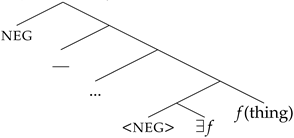 | ||||||
| (49) | Single negation reading in non-NC grammar (Dutch) | |||||
| a. | Ik | heb | niemand | gezien. | (van der Auwera and Van Alsenoy 2018, p. 117) | |
| I | have | n-person | seen | |||
| ‘I haven’t seen anybody.’ | ||||||
| b. | Step 0: input to morphology | |||||
 | ||||||
| c. | Step 1: duplication | |||||
 | ||||||
| d. | Step 2: deletion | |||||
 | ||||||
| e. | Step 3: bundling | |||||
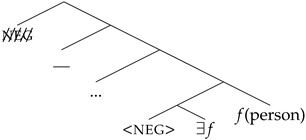 | ||||||
In order to derive double negation readings, the semantic structure has to contain two neg components. For non-NC grammars, this automatically leads to the spell out of two neg components, matching the surface structure in (50a). The derivational steps are given in (50c) to (50e). In (50c), neg-duplication applies due to the presence of the lower neg operator. In (50d), this lower neg operator is targeted by neg-deletion. After bundling is applied, the output structure in (50e) predicts the realisation of the negative marker niet in (50a).
| (50) | Double negation reading in non-NC grammar (Dutch) | ||||||
| a. | Ik | heb | niet | niets | gezegd. | (Giannakidou and Zeijlstra 2017, p. 8) | |
| I | have | not | n-thing | said | |||
| ‘I haven’t said nothing.’ (I have said something) | |||||||
| b. | Step 0: input to morphology | ||||||
 | |||||||
| c. | Step 1: duplication | ||||||
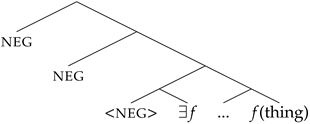 | |||||||
| d. | Step 2: deletion | ||||||
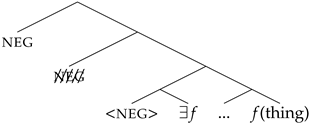 | |||||||
| e. | Step 3: bundling | ||||||
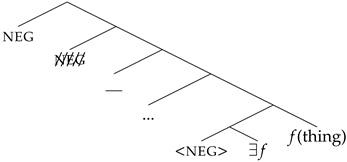 | |||||||
The rationale so far allows for double negation readings in NC grammars, though with the negative marker spelled out twice. We will come back to this point at the end of this section.
Let us now discuss sentences with multiple NCIs. Sentences with more than one NCI receive single negation readings in NC grammars. In (52), we show how this surface structure is derived from an underlying semantic structure with only one neg component. The key to capturing such structures is the assumption that morphological rules can iterate but always apply in an ordered block of rules, where each rule can only apply once and within the same DP, i.e., to the same indefinite. The iteration stops when the output structure is equal to the input structure, i.e., when none of the rules give rise to anymore changes. We visualize the rule block in (51). Given that negation may appear in a position other than the clause-initial one, a linearization algorithm will have to apply after the rule block (but before realization of concepts) which is capable of linearly reordering (certain) concepts thereby capturing the word order restrictions of a given language.
| (51) | Order of application of morphological rules |
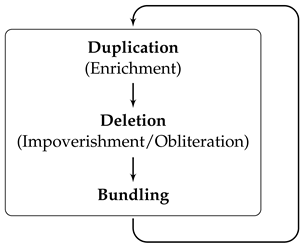 |
Since (52a) contains two indefinites, the semantic structure (52b) contains two choice functions. The duplicate created by neg-duplication in (52c) forms a constituent with one of the choice function determiners, which is subsequently bundled with the choice function variable in (52d). This in turn creates a local configuration for neg-duplication to apply again, this time in the context of the other choice function (52e), which initiates a second cycle of application of the rule block in (51). The constituent formed by the neg duplicate and the other choice function determiner is bundled with the variable at the tail of the other dependency (52f). Any further iterations of (51) would not change the output structure, thus, the process is terminated.
| (52) | Multiple NCIs in NC grammar (Hungarian) | |||||
| a. | Senki | nem | látott | semmit. | (Giannakidou and Zeijlstra 2017, p. 9) | |
| n-person | not | saw | n-thing | |||
| Noone said anything.’ | ||||||
| b. | Step 0: input to morphology | |||||
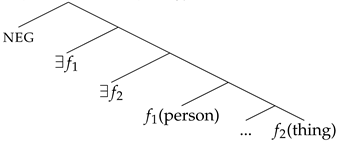 | ||||||
| c. | Step 1: duplication | |||||
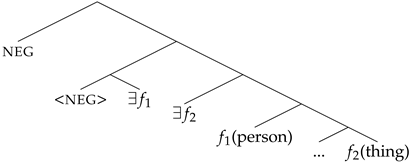 | ||||||
| d. | Step 2: bundling | |||||
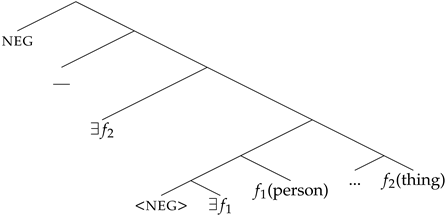 | ||||||
| e. | Step 3: duplication | |||||
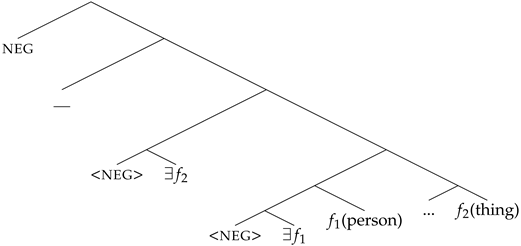 | ||||||
| f. | Step 4: bundling | |||||
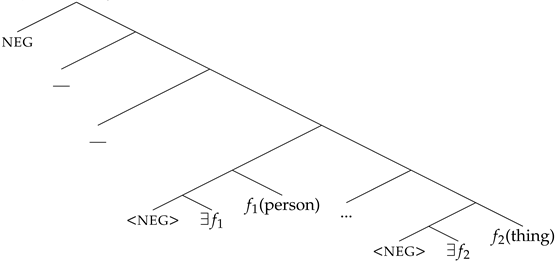 | ||||||
In non-NC grammars, each NCI introduces semantic negation. Hence, the sentence in (53a) receives a double negation reading. The semantic structure that derives this reading is given in (53b), which subsequently leads to neg-duplication (53c) for one of the choice function determiners, followed by neg-deletion (53d). The duplicate plus choice function determiner is bundled with the respective choice function variable in (53e). Since there is another local configuration that triggers neg-duplication to apply, the entire rule block applies again, this time with the other choice function determiner, see (53f)–(53h).
In contrast to (50a), no overt negative marker occurs in the surface structure in (52a), as both neg operators are deleted before vocabulary insertion takes place. This crucially follows from the locality restrictions imposed by neg-deletion. In (53d) and (53g), the neg operator is local to an existential, thus can be targeted by neg-deletion. In (50d), however, only the lower neg operator is local enough to the existential to be targeted by neg-deletion, resulting in the overt realisation of the negative marker.
| (53) | Multiple NIs in non-NC grammar (Dutch) | |||||
| a. | Niemand | heeft | niets | gezegd. | (Giannakidou and Zeijlstra 2017, p. 8) | |
| n-person | has | n-thing | said | |||
| ‘Nobody has said nothing.’ (Everybody has said something) | ||||||
| b. | Step 0: input to morphology | |||||
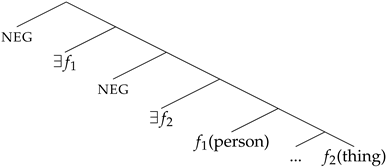 | ||||||
| c. | Step 1: duplication | |||||
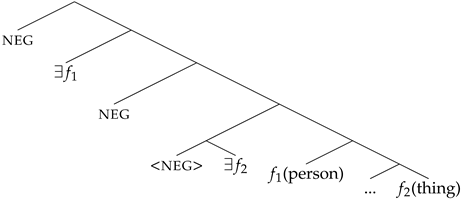 | ||||||
| d. | Step 2: deletion | |||||
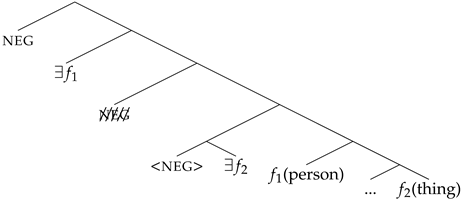 | ||||||
| e. | Step 3: bundling | |||||
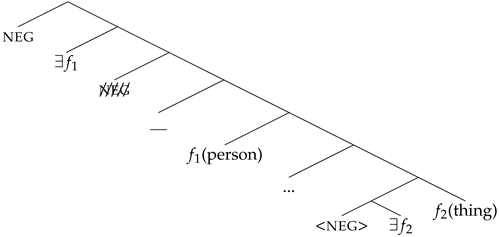 | ||||||
| f. | Step 4: duplication | |||||
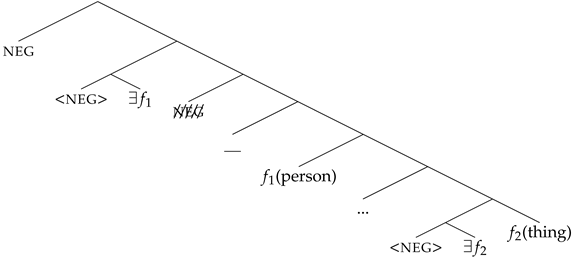 | ||||||
| g. | Step 5: deletion | |||||
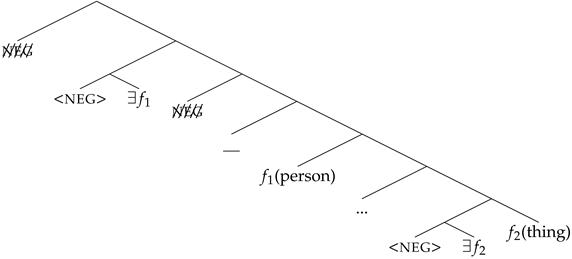 | ||||||
| h. | Step 6: bundling | |||||
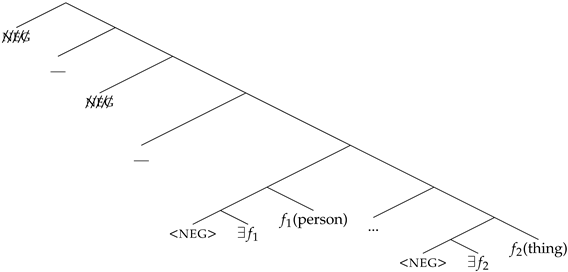 | ||||||
It is not possible for (53a) to receive a single negation reading, due to the presence of neg-deletion. We show the crucial derivation steps in (54). The semantic input for a single negation reading (54b) leads to duplication and deletion as shown in (54c). While subsequent bundling created a local configuration between neg and the other choice function determiner in NC grammars (52e), it has no effect in non-NC grammars since neg was deleted in a previous step, see (54d). Hence, no additional duplication is triggered which could potentially result in the surface structure in (53a). Instead, the output of (54) is: Niemand heeft iets gezegd ‘Nobody said something’, after bundling with (thing) which produces a positive indefinite in object position.20
| (54) | No single negation reading for multiple NCIs in non-NC grammars | |
| a. | Intended output: Niemand heeft niets gezegd. | |
| b. | Step 0: input to morphology | |
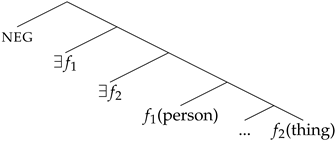 | ||
| c. | Step 1 & 2: duplication, deletion | |
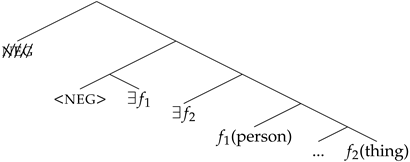 | ||
| d. | Step 3: bundling | |
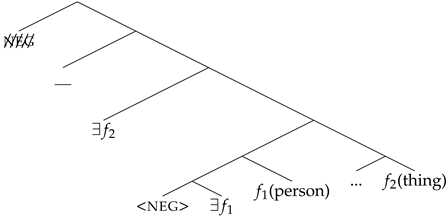 | ||
Now that we have derived the crucial contrasts between NC and non-NC grammars, we can finally turn to the availability of double negation readings in NC grammars. Giannakidou and Zeijlstra (2017, p. 8) report that many NC languages block double negation readings, while some allow it as a marked or less preferred alternative to a single negation reading, often with a special intonation contour and a dedicated information structure (see ex. (4) and Note 1, and also de Swart 2010; Déprez et al. 2015; Espinal et al. 2015; Fălăuş 2009; Puskás 2012). Since we cannot do justice to the broad cross-linguistic variation in this area, we focus on the contrast in (55) and provide a solution within the reduplication account proposed in this section. The most intuitive way to trigger double negation readings in NC grammars is by producing the negative marker twice. As can be seen for the NC language BCS in (55a), this results in unacceptability. Interestingly, a NC language like Turkish is able to produce a double negation reading (55b) by making use of two morphologically distinct negative markers, the affixal -mA and the negative auxiliary deǧil.
| (55) | Double negation readings in NC grammars? | |||||||
| a. | * | Milan | ne | ne | vidi | ništa. | BCS | |
| Milan | not | not | sees | nothing | ||||
| ‘Milan doesn’t see nothing.’ (Milan sees something) | ||||||||
| b. | Hiçbir şey | gör-me-müş | deǧil-di-m. | Turkish | ||||
| nothing | see-neg-prf | neg-pst-1sg | ||||||
| ‘It was not that I had not seen anything.’ | (Özdemir 2020 | |||||||
We can attribute the unacceptability of (55a) to the OCP (prohibition of adjacent identical elements; see Goldsmith 1979; Leben 1973; McCarthy 1986; Odden 1986 for the OCP in phonology and Ackema 2001; Menn and MacWhinney 1984; Perlmutter 1971; van Riemsdijk 1998; Yip 1998 for its application in (morpho-)syntax; see further Richards 2010 on Non-Distinctness and Neeleman and van de Koot 2006 on syntactic haplology effects). The structure in (56) presents the output of the rule block in a NC grammar. Crucially, the two neg concepts will cause a violation of the OCP if they are realised by the same exponent, as in (55a) for BCS.21
| (56) | Double negation readings cause an OCP effect |
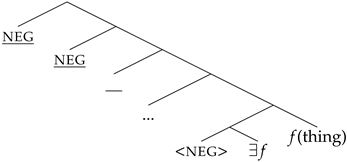 |
There is additional evidence that speaks in favour of attributing the lack of double negation readings to an OCP effect. Fălăuş and Nicolae (2016) observe that double negation readings are readily available in NC grammars in fragment answers to negative questions. They verified this observation for eight strict NC grammars, corroborating a previous study by Espinal and Tubau (2016) who made the same observation for non-strict NC languages (see also the Italian adult responses in Moscati 2020 mentioned in Section 2.1). Fălăuş and Nicolae (2016) illustrate the data with Romanian, a strict NC language, see (57). What these data reveal is that the OCP can be circumvented by ellipsis: If the two neg concepts are elided before vocabulary insertion is taking place, no problem arises with the OCP and thus double negation readings are readily available.
| (57) | Double negation reading in fragment answers | (Fălăuş and Nicolae 2016, p. 586) | ||||
| A: | Cine | nu | a | venit? | Romanian | |
| who | not | has | come | |||
| ‘Who didn’t come?’ | ||||||
| B: | Nimeni. | |||||
| n-person | ||||||
| ‘Nobody.’ | ||||||
| Nobody came … You’re the first one here. | ||||||
| Nobody didn’t come … Everybody’s here. | ||||||
In this section, we have shown how the morphology of NCIs and NIs can be derived via the interaction of a reduplication and a deletion rule, thereby dispensing with the need for Upward and Multiple Agree. In contrast to the Agree accounts, this approach also provides a natural explanation for why negative markers obligatorily occur with NCIs in NC grammars. It is the negative marker that introduces semantic negation, thus its presence is required to derive a negative statement. There is no abstract negative operator (Op) in this system which could take over this function. The only way to derive covert sentence negation is by a deletion rule, which targets the very same negative marker. This deletion rule is, as we propose, only operative in non-NC grammars. Moreover, the current account can readily explain why positive indefinites cannot co-occur with the negative marker in NC and non-NC languages. Since neg-duplication applies before bundling, a <neg> duplicate will be created as soon as the underlying semantic structure contains a negative operator scoping over an existential, ultimately turning the indefinite into a negative indefinite. In this sense, the morphological form of the indefinite is directly influenced by the presence of negation. Consequently, the absence of negation leads to positive indefinites, as no duplicates are created. Agree-based accounts, however, cannot explain why positive indefinites are blocked under sentence negation since the licensing of NCIs/NIs via Agree has no bearing on the occurrence of positive indefinites. Finally, as discussed earlier, the choice function analysis provides a new insight into why concord is tied to indefinite determiners cross-linguistically, and not for example definite determiners. For Agree approaches at least, there is nothing in these systems that prevents other types of determiners to come with a [uNeg]- or [nw]-feature.22
In the next section, we will discuss two extensions to the current approach. One is concerned with non-strict NC grammars, the other is devoted to capturing the patterns of English varieties.
4.2. Extensions of the Reduplication Approach
Non-strict NC grammars are like strict NC grammars in that they apply neg-duplication and bundling to the exclusion of neg-deletion. In order to account for the preverbal pattern of non-strict NC languages, we will make reference to allomorphy which we assume to operate under linear adjacency. In particular, we propose that non-strict NC languages display an additional zero allomorph for neg which appears if neg is linearized immediately following an existential. As this type of allomorphy is fairly uncontroversial (Embick 2010) and easy to adjust across languages, we believe this approach is flexible enough to account for the considerable cross-linguistic variation and the general rarity of non-strict NC grammars (Kahrel 1996; van der Auwera and Van Alsenoy 2016). To illustrate our idea, we present the relevant minimal pairs for a non-strict NC grammar like Italian in (58). For post-verbal NCIs, Italian patterns with strict NC grammars like Hungarian, in that the negative marker has to be realised overtly (58a). Pre-verbal NCIs, however, lead to zero exponence of the negative marker like in non-NC grammars, see (58b) and (58c).
| (58) | Non-strict NC languages (Italian) | (Giannakidou and Zeijlstra 2017, pp. 9–11) | ||||||
| a. | Non | ha | telefonato | nessuno. | ||||
| not | has | called | n-body | |||||
| ‘Nobody called.’ | ||||||||
| b. | Nessuno | ha | telefonato. | |||||
| n-body | has | called | ||||||
| ‘Nobody called.’ | ||||||||
| c. | Nessuno | ha | telefonato | a | nessuno. | |||
| n-body | has | called | to | n-body | ||||
| ‘Nobody has called anybody.’ | ||||||||
We provide a representative set of vocabulary items (VIs) for a non-strict NC grammar like Italian in (59). Non-strict NC languages display a zero allomorph of neg in the context of an indefinite (59a). This allomorphy operates on linear adjacency, which explains why the negative marker is overtly exponend only in (58a), but not in (58b) and (58c) where it is adjacent to the indefinite argument.23 Note that the contextual restrictions on vocabulary items do not necessarily indicate scope (in contrast to neg-duplication and neg-deletion) since linearization of concepts applies before vocabulary insertion takes place. Hence, a scopal configuration can be made opaque by whatever is written into the linearization rules of the individual grammar. Thus, the entry in (59a) does not indicate that the existential takes scope above negation but rather that the existential is linearized before negation (which in such cases is not pronounced).
| (59) | VIs for non-strict NC grammar, Italian | |
| a. | /⌀/ ⇔ [neg] / ∃ __ | |
| b. | /non/ ⇔ [neg] | |
| c. | /nessuno/ ⇔ [neg,∃] | |
Let us now turn to the English patterns. As was discussed in the previous sections, English (varieties) display NC utterances and non-NC utterances in free variation (Blanchette 2015; Robinson and Thoms 2021; Tubau 2016). Some corpus examples from UK-based varieties of English are given in (60). Examples (60a) and (60d) are from the same variety and show the variation very clearly. Example (60e) shows a non-NC sentence shortly followed by an NC sentence. Utterances containing NCIs receive single negation and double negation readings, as is e.g., documented for Appalachian English by Blanchette (2015, p. 18).
| (60) | NC and non-NC sentences in UK-based varieties of English (Tubau 2016) | ||
| a. | But he had no music | (Outer Hebrides) | |
| b. | Well you got nothing | (Nottinghamshire, Midlands) | |
| c. | And beyond that nobody couldn’t go | (Glamorgan, Wales) | |
| d. | I didn’t say nothing | (Outer Hebrides) | |
| e. | Mi father had no work at all, and couldn’t get a job nowhere | (Lancashire, North) | |
Given that both NC and non-NC variants exist, there seems to be enough evidence for learners to postulate a neg-duplication and a neg-deletion rule. Yet the system is less restricted than a non-NC grammar. We therefore propose that English varieties can be derived within the current system by a partial order of rules. An overview of the typology is shown in (61), repeating the rules and their orders that make up NC and non-NC grammars from the previous section, and adding the partial order for English varieties.
| (61) | Rule orders | |
| a. | NC grammar: neg-duplication ≺ bundling | |
| b. | non-NC grammar: neg-duplication ≺ neg-deletion ≺ bundling | |
| c. | English varieties: { neg-duplication, neg-deletion } ≺ bundling | |
The variation observed in English varieties is the result of the availability of two orders, one being neg-duplication ≺ neg-deletion ≺ bundling (the order for non-NC grammars) and the other being neg-deletion ≺neg-duplication ≺ bundling. The former derives utterances like (60a)–(60b) and double negation readings for (60c)–(60d), see the previous section for detailed derivations. The latter derives single negation readings for (60c)–(60d), in effect deriving the NC variants in English dialects. In (62), we illustrate how this data point can be derived based on the example in (60d). Given that we want to derive a single negation reading, only one neg operator is present in the underlying semantic structure (62b). The first rule in the rule block is neg-deletion. Note, however, that the context for neg-deletion to apply is not given.24 As is specified in (43b), this rule only applies in the presence of another neg and an existential. Thus, we move on to the next rule which is neg-duplication, see (62d). This creates a neg duplicate, which will eventually be linearized together with the indefinite at the base position of the argument (62e). The output of the underlying structure corresponds to a sentence involving NC.
| (62) | Single negation reading of NC sentence in English dialect | |
| a. | I didn’t say nothing. | |
| b. | Step 0: input to morphology | |
 | ||
| c. | Step 1: deletion (does not apply) | |
 | ||
| d. | Step 2: duplication | |
 | ||
| e. | Step 3: bundling | |
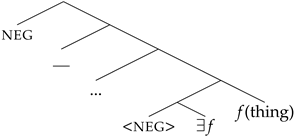 | ||
With a minimal change in the order of application, we have now managed to extend our system of rule interaction to a more permissive pattern of NC that can be found in English varieties. The fact that neg-deletion and neg-duplication can apply in either order leads to a language that allows for more variation, where NIs on their own as well as NCIs can be found, and sentences with NCIs trigger single and double negation readings. Note that we have only discussed English varieties so far. Blanchette and Lukyanenko (2019a); Blanchette (2015, 2017); Robinson (2022); Robinson and Thoms (2021) argue that Standard English behaves just like the English varieties, but the NC variants, that is the output in (62e), are socially stigmatized. The difference between Standard English and English dialects is derived in our system by a strict order vs. a partial order of morphological operations.
4.3. Children’s Production of Negative Concord
Finally, let us address the NC-type errors children make when acquiring non-NC languages like German, English, and Dutch. The Meaning First model takes commission errors made by children during acquisition as evidence for the underlying conceptual structure (Guasti et al. 2023). Moreover, children are assumed to prefer a one-to-one correspondence with regard to the realisation of concepts, that is children are predicted to prefer the expression of each underlying semantic component overtly. While NC is a phenomenon that also introduces redundancy, specifically non-NC grammars additionally require children to learn compression, that is they must learn to not overtly realise the neg operator. Hence, we expect children to initially pronounce the neg operator while acquiring non-NC grammars, resulting in the NC-type errors (11)–(13) reported in Section 2.2, where the negative marker is produced together with the NI. We provide two further examples from the corpus study for illustration in (63) and (64).
| (63) | Kein | Teller | kann | s | net | sein. | German |
| no | plate | can | it | not | be | ||
| ‘It can’t be a plate.’ | (Sebastian 5;04, Lieven and Stoll 2013) | ||||||
| (64) | Ik | zie | geen | andere | olifanten | niet | meer. | Dutch |
| I | see | no | other | elephants | not | more | ||
| ‘I don’t see any other elephants anymore.’ | (Matthijs 3;01, Wijnen and Verrips 1998) | |||||||
The current system has a straightforward way to account for such commissive productions. Non-NC grammars display two rules which introduce opaqueness into the system. The neg-duplication rule disrupts the one-to-one mapping and the neg-deletion rule compresses a semantic operator. We provide the overview in (65).
| (65) | Compressor rules that disrupt one-to-one mapping | |
| a. | NC grammar: neg-duplication | |
| b. | non-NC grammar: neg-duplication ≺ neg-deletion | |
| c. | English varieties: { neg-duplication, neg-deletion } | |
Let us start with the discussion of NC-type errors for German and Dutch, that is the data in (12), (13), (63), and (64). Recall from Section 2.2 that children produce NC-type utterances alongside (target) non-NC utterances. A natural way to account for this pattern is to assume that in the acquisition of a non-NC grammar (65b), children do not apply neg-deletion consistently. In such cases, the <neg> duplicate is created but neg itself is not deleted, leading to NC utterances (compare the derivations for NC grammars). If neg-deletion is applied, a non-NC utterance is created. Following this rationale, we predict another type of error, namely when in children’s utterances neither neg-deletion nor neg-duplication is applied. Following the logic of our rule system, children would produce sentences containing sentential negation and a regular, that is, non-negatively marked indefinite taking narrow scope.25 In the same context, the most natural way for adult speakers to express this meaning would be to use a NI. Indeed, we find such examples, shown in (66)–(68), where the child produces positive indefinites in the scope of sentence negation in the immediate context of the parent’s target-like production of a NI.
| (66) | CHI: | und | ich | wollte | xxx | nich(t) | eine | Pause | machen. | German |
| and | I | want | not | a | pause | make | ||||
| ‘and I don’t want to take a break’ | ||||||||||
| FAT: | nee, | da | machen | wir | keine | Pause. | ||||
| no | there | make | we | no | pause | |||||
| ‘No, we don’t take a break there.’ | Leo (3;08, Behrens 2006) | |||||||||
| (67) | CHI: | die | haben | nich(t) | was | getut [: | getan][*]. | German |
| they | have | not | something | doed | done | |||
| ‘they haven’t done anything.’ | ||||||||
| FAT: | was, | die | haben | dir | nichts | getan. | ||
| what | they | have | you | nothing | done | |||
| ‘what, they haven’t done anything to you.’ | Leo (2;06, Behrens 2006) | |||||||
| (68) | MOT: | omdat | je | geen | onderbroek | aan | had. | Dutch |
| because | you | no | pants | on | had | |||
| ‘because you had no pants on’ | ||||||||
| CHI: | ja! | nee! | ||||||
| yes | no | |||||||
| ‘Yes! No!’ | ||||||||
| MOT: | doe | maar | gauw | een | onderbroek | aan. | ||
| do | prt | quickly | a | pants | on | |||
| ‘Put pants on quickly!’ | ||||||||
| CHI: | nee! | |||||||
| MOT: | ja. | |||||||
| CHI: | wil | niet | een | onderbroek. | ||||
| want | not | a | pants | |||||
| ‘I don’t want pants on.’ | Abel (2;11, Wijnen and Verrips 1998) | |||||||
A search on this type of error in the corpora for German and Dutch investigated in Section 2.2 revealed that they are overall more frequent than erroneous negative concord. We found 48 of these errors (which we call ‘decomposition errors’) in Dutch amounting to an overall error rate of 5.3%. For German, there were 67 of these errors which corresponds to an overall error rate of 2.5%.26 Our account naturally derives the simultaneous presence of both types of errors, along with target-like productions.
We will now turn to the production errors from English children. As with the German and the Dutch data, NC-type utterances were produced alongside non-NC sentences, though the number of NC errors was much higher for English. Note that the children’s production data matches the output we derived from the partial order we proposed for English dialects, as is also shown in (65c). In the previous section, we hypothesized that the difference between English dialects and Standard English is derived by a partial vs. fixed order of neg-duplication and neg-deletion, where the fixed order can also be seen as a social stigma. A reasonable analysis of the NC-type utterances of children acquiring Standard English is therefore that children are not aware of the social stigma and thus apply the two operations in both orders. This can potentially explain why the number of NC errors is higher, or in any case different, for children acquiring English than for children acquiring Dutch and German. Such a developmental path would be consistent with grammar rules being acquired earlier than pragmatic or social-linguistic cues. More concretely, we can capture the first phase of errors, observed for all three languages in Figure 2, as the acquisition of both rules and a fixed order of application such that neg-duplication precedes neg-deletion. The second phase in English then is due to the acquisition of NPIs, as discussed in Hein et al. (2023), but also to the fact that the English children reassess the order of rules to allow for partial ordering. This partial order enables NC and is only restricted (in Standard English) at later ages when children eventually master pragmatic factors such as the social stigma associated with NC.
One prediction that our account makes concerns possible errors made by children acquiring a (strict) NC language. Assuming that both rules, neg-duplication and neg-deletion, are learned from the input, those children have little to no reason to postulate a neg-deletion rule as their input negative sentences almost always include the negative marker that realizes the position of the original neg concept (cf. Note 24). In contrast, there is abundant evidence for the neg-duplication rule. Therefore, under the approach presented here they are expected to produce decomposition errors, either because they might not have acquired neg-duplication yet or because they fail to apply it consistently. In the absence of other sources for omission errors, however, they should not produce sentences that contain a NCI but lack the negation marker.
A further prediction is made about learning. Learners of a DN language like German or Dutch will have to acquire two rules (and their correct order of application) whereas learners of a NC language like Hungarian need to acquire only one rule (and no restriction on order of application). Therefore, NC languages should be in some sense easier to acquire than DN languages. Some support for this comes from Maldonado and Culbertson (2021) who show that an artificial language with NC is acquired faster and more reliably than a language with DN by adult learners. Languages that lack NC or NIs altogether and express their meaning by sentential negation and a regular indefinite (as mentioned in Note 25) should in turn be easier to acquire than NC languages as they involve no dedicated rule for the expression of negation. An indication that this learnability hierarchy between the three types of languages is correct comes from the typological study in van der Auwera and Van Alsenoy (2016). Based on a typologically balanced sample of 179 languages they show that 49.7% of them use a verbal negation marker plus a regular indefinite, 19% show negative concord and only 11.7% have NIs of the Dutch and German kind. If we accept that languages are more common across the world at least partly because they are easier to acquire than others, van der Auwera and Van Alsenoy’s work corroborates our prediction. Despite these initial indications, a proper verification of these predictions requires further research. We leave this for future work here.
5. Conclusions
Previous work on the comprehension of sentences with several negative elements has found that children exhibit a strong tendency to assign a NC interpretation, both in non-NC languages like German and English (Nicolae and Yatsushiro 2022; Thornton et al. 2016), as well as in double negation contexts in NC languages like Italian (Moscati 2020). Results from an expanded corpus study on English and German (Hein et al. 2023), to which we added Dutch data, show that children produce a number of NC-type utterances in a certain phase of acquisition. In this paper, we have investigated if, and how, the three most current Agree-based approaches to NC and NIs as well as a movement-based account can handle this phenomenon, in addition to the typological variation in adult languages. While Zeijlstra (2004, 2011), and by extension Tubau (2016), is in principle able to derive the non adult-like productions, his account overgenerates, leaving us to expect types of errors that are unattested, at least in the corpora we investigated. Further, since he treats NC and NIs as properly distinct from each other, children’s errors cannot be taken to reflect an actual phase of acquisition where their grammar allows NC similar to that of adult speakers of a NC language. Instead, different mistakes in different types of languages (overgeneralization of NC in Italian vs. erroneous non-deletion of the negative operator part of the higher copy of a negative quantifier at PF in English and German) accidentally result in the same surface error. The other two Agree-based accounts (Deal 2022b; Penka 2007, 2011) were not evaluated, as it was unclear how they envisage the acquisition of the relevant phenomena to proceed. As for the adult cross-linguistic variation, we have argued that, in addition to requiring debated extensions of Agree, all three accounts face empirical shortcomings in accounting for the obligatory presence of the negative marker and the obligatory absence of positive indefinites in NC utterances of strict NC languages. While the movement account of Blanchette (2015) and Robinson and Thoms (2021) readily explains NC utterances for English-acquiring children, it does not straightforwardly extend to those of children who are acquiring Dutch or German. As far as adult language variation is concerned, both the obligatory presence of a negative marker in strict NC languages as well as the general restriction of NC to indefinites can arguably be accounted for. However, this comes for the price of difficulties with utterances containing multiple NCIs/NIs. At the heart of the problem for all approaches lies the fact that in the domain of NC and NIs there is an interaction between morphology and semantics that within the standard Y-model has to be mediated in the syntax. Exchanging this architecture for one in which semantic representations feed morphology allowed us to propose a purely morphological account which does without Agree and captures the empirical generalizations of strict NC languages. The approach involves morphological rules that duplicate the underlying (semantic) negation and place the duplicate in a constituent with the indefinite to be pronounced as a NI. Depending on the presence or absence of a complementary deletion rule, dictates whether a given language is a non-NC language or a (strict) NC language. In addition to providing a neat account of (the absence of) double negation readings in most contexts in NC languages, our account also captures children’s NC-type and decompositional productions. They result from a phase of acquisition where neither the duplication rule nor the deletion rule are a robust part of the child’s grammar. For English in particular, we argue that acquiring the fixed order of rules based on social cues is an added complication.
Author Contributions
Conceptualization: I.D., J.H.; Methodology: I.D., J.H., C.B., A.G., I.I., P.J.; Data Curation: I.D., J.H., C.B., A.v.A.; Formal Analysis: I.D., J.H.; Writing—original draft: I.D., J.H., C.B.; Writing—review and editing: I.D., J.H. All authors have read and agreed to the published version of the manuscript.
Funding
This project has received funding from the European Research Council (ERC) under the European Union’s Horizon 2020 research and innovation programme (LeibnizDream, grant agreement No. 856421).
Institutional Review Board Statement
Not applicable.
Informed Consent Statement
Not applicable.
Data Availability Statement
All data used in this study are publicly available through the Child Language Data Exchange System (ChiLDES) database at https://childes.talkbank.org/.
Acknowledgments
We thank all members of the LeibnizDream project for fruitful discussions of the ideas presented in this paper and the audiences at the Syntax Kolloquium at Goethe-Universität Frankfurt, CGSW 36, CLS 58 and GALA 15 for their helpful comments on various parts of this work. Furthermore, we extend our thanks to four anonymous reviewers of Languages whose criticism and comments have helped to improve the original manuscript significantly.
Conflicts of Interest
The authors declare no conflict of interest. The funders had no role in the design of the study; in the collection, analyses, or interpretation of data; in the writing of the manuscript; or in the decision to publish the results.
Notes
| 1 | A similar emergence of double negation readings, given the right pragmatic and prosodic conditions, has also been shown to be possible in Spanish and in Catalan (Déprez et al. 2015; Espinal et al. 2015), where the latter could be treated as a strict NC-language as it optionally allows a negative marker to co-occur with a preverbal NCI. | |||||||||||||||||||||||||||
| 2 | A reviewer points out that Late Latin had a similarly hybrid status allowing both NC and DN sentences (cf. Gianollo 2016) which evolved into the NC systems present in modern day Romance languages (cf. Greco 2022 on the development of NC in Modern Italian). | |||||||||||||||||||||||||||
| 3 | In contrast to English, German and Dutch varieties are not dominated by NC dialects. While there are some local dialects in each language, the phenomenon does not appear to be widespread. Zeijlstra (2004, p. 6) argues that “the majority of Dutch dialects are DN [double negation] varieties”. For German, there have been claims that it is a ‘hidden’ NC language where, similar to what is suggested for English by Blanchette (2017), the underlying NC nature is occluded by a prescriptive drive to omit the sentence negation (Weiß 2004). These claims, however, have not gone uncontested; e.g., Jäger (2008, p. 180)’s statement that“it appears exaggerated to claim that most present-day dialects of German are NC languages”. Perhaps more importantly, we are unaware of any experimental results showing German adults’ acceptance of NC readings (analogous to the ones for English in Blanchette 2017). Therefore, we continue to treat synchronic German as a DN language. This perspective is further supported by the much smaller NC error rates of German-acquiring children when compared to their English-acquiring peers in our corpus study presented in Section 2.2. That said, if German should emerge as a ‘hidden’ NC language after all, it could be accounted for in the same way as English, namely by having a partial rule order (see Section 4.2). | |||||||||||||||||||||||||||
| 4 | It is, of course, still possible that children had some NC input from other speakers in their environment (e.g., peers or extended family). | |||||||||||||||||||||||||||
| 5 | Note that in both examples the NI geen ‘no’ appears right-adjacent to the negative marker niet. In some spoken non-standard adult varieties of Dutch, geen in this position allows for NC with the negative indefinite nooit ‘never’. | |||||||||||||||||||||||||||
| 6 | We would like to thank an anonymous reviewer for this suggestion. | |||||||||||||||||||||||||||
| 7 | It should be mentioned that Thornton et al. (2016) did consider this possibility and attempted to show that their child participants were able to process two negations by means of control items such as (i) below. These elicited 84% correct responses showing that children were able to process two negations within a sentence.
However, as the two negations in (i) appear in distinct clauses, this does not exclude the possibility that they were still unable to properly process two negations in a single clause (i.e., CP or proposition) such as they appeared in the test items. | |||||||||||||||||||||||||||
| 8 | In order to prohibit general indefinites from occurring in the scope of negation, one could assume that there is just a single lexical item for each pair of NCI and (general) indefinite (e.g., nitko-netko ‘nobody-somebody’, ništa-nešto ‘nothing-something’, etc. in BCS) and that this item carries a [uNeg] feature. The [uNeg] feature probes upwards. If it encounters a negation with a [iNeg] feature, its [uNeg] feature is checked under Agree, which we can take to be reflected on the indefinite by some change in the featural specification. For concreteness, we could assume that the [uNeg] feature loses its probehood and turns into a [
This solution, however, requires Agree to be fallible (Preminger 2011). To see this, consider a case where the indefinite item with a [uNeg] feature occurred in a sentence without negation. Its [uNeg] feature would probe in vain, not finding any negation to be checked against. The unchecked [uNeg] feature should then cause the derivation to crash at the interfaces giving rise to the expectation that general indefinites in a positive sentence should never be grammatical. In order to not crash the derivation, Agree needs to be fallible. The unchecked feature then leads to the item being realised as a regular indefinite at PF. This system ensures that the regular indefinite form only appears when there is no negation for the indefinite to Agree with and in turn enforces the NCI form when negation is present. | |||||||||||||||||||||||||||
| 9 | There are two main points where it seems to us that some notion of Upwardness will reappear in a detailed implementation of the mechanisms. The first point concerns the enforcement of Agree. Recall that Deal assumes that the NCI morphology is what is licensed via Agree between a negation and a NCI. “Surface forms like niente and nessuno require semantic negation not due to a need to check a [uNeg] feature in the syntax (as Zeijlstra had proposed), but rather as a source of the agreement that gives rise to their distinctive morphology. If there were no Agree with Neg, these indefinites simply could not be pronounced in this way.” (Deal 2022b, p. 4). The question is how this licensing, i.e., the ineffability of NCIs that have not undergone Agree with a negation, is enforced. What prevents a derivation with NCIs but without (overt or covert) negation from converging? The feature [nw] supposedly involved in Agree is per se not able to derive this result. Suppose that the [nw] is realised by NCI morphology. This seems reasonable as [nw] only appears on NCIs but not on regular indefinites. Since [nw] remains part of an NCI’s featural make-up whether it has been interacted with by some probe or not, the NCI will be realised by NCI morphology in any case, including one where Agree has not taken place. To enforce Agree one would have to mark the [nw] feature with a diacritic that somehow blocks realisation by NCI morphology and that only vanishes if the feature has been interacted with in an Agree relation. This diacritic would essentially be equivalent to the u in [uNeg]. Just as u leads to a crash at the interfaces, the diacritic leads to non-realisability by NCI-morphology, e.g., by ‘hiding’ the [nw] feature from vocabulary insertion. Under this view NCIs are probes in the sense that they require the Agree relation to hold. From the perspective of technically initiating an Agree algorithm, of course, NCIs could still be goals. However, if probehood is defined by initiating the algorithm, then the issue of Upward vs. Downward Agree becomes vacuous as given sufficiently elaborate technical machinery it is always possible to define either member of the relation as the starter. The second point is different from, though related to the first one. Concerning the question how Agree with negation gives rise to NCI morphology, Deal (2022b, fn. 6) suggests that “interaction with Neg results in an [i:neg] feature on goals”. Vocabulary items of NCIs are specified for this feature whereas those of regular indefinites are not, correctly deriving their distribution. However, the proposal raises one question: Where does [i:neg] come from? Simply introducing it whenever Agree with a negator has taken place is in conflict with the Inclusiveness Condition (Chomsky 1995, 2000). Alternatively, the feature could be copied to the indefinite from another element when the indefinite agrees with negation. The most straightforward claim is that it is copied from the negator itself when the latter agrees with (and copies) the indefinite’s [nw] feature. Thus, each NCI would have to bear a feature [int:{i:neg}] that interacts with and copies the negator’s [i:neg] feature. This amounts to there being two Agree relations between a negator and a NCI, one for [nw] and another for [i:neg]. Crucially, in the latter the NCI acts as the probe in an Upward Agree relation. Further, this Agree relation renders the whole Downward Agree for [nw] unnecessary. Thus, the problem with negative concord that lead to the postulation of Upward Agree is not interpretability (pace Deal 2022b). Rather, it is the fact that an indefinite changes its form in the presence of negation and not vice versa. In other words, the NCI is dependent upon negation but the negation is not dependent upon the NCI. Any account of NC that involves Agree therefore necessarily also involves some Upward Agree (Preminger 2013; Preminger and Polinsky 2015; Zeijlstra 2004), if not technically then at least conceptually. | |||||||||||||||||||||||||||
| 10 | Note that the structure in (33c) does not derive split scope data with modals, which were illustrated in (20). Additional assumptions have to be made, possibly some covert neg raising, or QR in combination with partial deletion as in Zeijlstra (2011). | |||||||||||||||||||||||||||
| 11 | This problem potentially also exists for English NC structures containing more than one NCI. | |||||||||||||||||||||||||||
| 12 | One might wonder whether this is a welcome result for English given that the translation in (32b) seems acceptable. Again, English dialects pattern differently from NC grammars and non-NC grammars in this respect. | |||||||||||||||||||||||||||
| 13 | Interestingly, the more recent accounts of NC in English (Blanchette 2015; Robinson and Thoms 2021) do in fact draw a close connection to morphological realization rules, at least when it comes to the choice between an NPI (any) and an NCI (no) under negation. However, as was discussed in Section 3.3, the choice between an NC utterance and a non-NC utterance is still determined by a syntactic feature, that is, whether the neg component raises or not. | |||||||||||||||||||||||||||
| 14 | We thank an anonymous reviewer for bringing these references to our attention. | |||||||||||||||||||||||||||
| 15 | One reviewer asks why we should consider negation to be a primitive concept available in the semantic structure. Note that neg does not necessarily have to be a primitive or ‘innate’ concept to be available in thought structures. Nothing precludes neg from being a concept that is acquired through the input or indeed from being a complex one, itself consisting of even more primitive concepts, although that would probably complicate the structures and the analysis proposed here. That said, Sauerland and Alexiadou (2020, p. 2) state that “[t]he Generator of the thought-system forms complex thought representations from an inventory of logical primitives”. Negation as a logical constant that is present in some form in virtually all flavours of logic arguably belongs to this inventory of logical primitives. In addition, in Guasti et al. (2023, p. 6, ex. (9))’s Antonym generalization they explicitly assume that among others negative quantifiers have to be decomposed into negation and an unmarked existential which we take to imply that negation is available as a concept in thought structures. | |||||||||||||||||||||||||||
| 16 | This in-situ analysis aligns in spirit with many other, mostly semantic, NC accounts (Acquaviva 1993; Déprez 2000; Giannakidou 1998; Giannakidou and Quer 1997; Ladusaw 1992, etc.). | |||||||||||||||||||||||||||
| 17 | For one thing, as Meaning First enforces radical decomposition, Abels and Martí’s negative existential quantifier , which they treat as a single constituent, is decomposed into the two separate constituents neg and exists in our approach. For another, while the negative existential quantifier is merged close to its restrictor NP and undergoes movement via QR to its final position in Abels and Martí (2010)’s approach, neg and exists are base-generated in this high position in a Meaning First approach because there is no (syntactic) movement available in this model. | |||||||||||||||||||||||||||
| 18 | Note that the contextual restriction of neg-duplication (43a) is written so that NCIs/NIs are only produced if the existential scopes under negation. We leave it open how wide scope existentials are derived. One option would be to assume that the existential binder scopes above negation, in which case (43a) does not apply and a positive indefinite is produced. Another option is to leave out the existential binder altogether, in which case the antecedent for the (skolemized) choice function variable is made salient in the discourse (Kratzer 1998). | |||||||||||||||||||||||||||
| 19 | We can think of a number of other areas involving semantic dependencies where bundling rules are relevant, e.g., -ex situ vs. -in situ languages, or inverse scope usually created by covert QR. | |||||||||||||||||||||||||||
| 20 | Note that the hierarchical order of the existential binders and has to match that of the arguments (person) and (thing) that they bind. Based on the derivation in (54b), we observe that there can only be crossing binding dependencies, not nested ones. Otherwise, one would generate the surface string Iemand heeft niets gezegd ‘Somebody said nothing’ which has a meaning where the subject indefinite outscopes negation. This meaning, however, is in conflict with the semantic input in (54) where negation outscopes both indefinites. We thank an anonymous reviewer for pointing this out. | |||||||||||||||||||||||||||
| 21 | Note that double negation with two identical negative markers in a row is possible in (at least some) non-NC languages (69), though with special prosody only.
We can assume that this prosody makes the two adjacent negative markers sufficiently different such that they circumvent the OCP. If however, a language has two different exponents at its disposal, a structure such as (56) can be realised, which happens to be the case in Turkish (55b). | |||||||||||||||||||||||||||
| 22 | Our account can be extended to expletive negation phenomena of the type investigated in Jin and Koenig (2020). They conducted a typological study across 722 languages, identifying cross-linguistic lexical triggers for the occurrence of expletive negation, including items like to fear, to deny, to regret, before, until, etc. We provide one example for English deny in (69), where it can be observed that the affixal negation in the complement clause selected by deny does not contribute semantic negation.
Given that many if not all of the lexical triggers can be considered one member of an antonym pair and the Antonym generalization in Guasti et al. (2023, p. 4) states that “the marked member of an antonym pair is never a primitive concept, but is composed of negation and the unmarked member of an antonym pair”, we can decompose the triggers into (at least) two smaller components one of which is negation. For example, think of a pair like believe–deny as an antonym pair where deny is composed of neg+believe. The neg component could then serve as a trigger for a duplication rule to apply, where the duplicate <neg> would surface as expletive negation. That rule, however, would have to be of a slightly different nature than our duplication rule, as the occurrence of expletive negation is optional and there is no existential necessarily occurring in the context. Note further that expletive negation has also been observed in children’s production of English utterances including without, see discussion in Green (2010); Martin et al. (2023). We thank a reviewer for pointing us to the parallel between NC and expletive negation. | |||||||||||||||||||||||||||
| 23 | Our account is independently supported by the observation that there seems to be a lot of micro-variation when it comes to non-strict NC grammars (van der Auwera and Van Alsenoy 2016), thus suggesting that a surface effect such as allomorphy via linear adjacency is the right type of approach. | |||||||||||||||||||||||||||
| 24 | Note that the counter-feeding of neg-deletion in this rule ordering gives the same results as the absence of neg-deletion in NC grammars (61a). Therefore, one could, in principle, also describe NC grammars as comprising the full set of rules in the order neg-deletion ≺neg-duplication ≺ bundling. However, we did not pursue this option because, given that the rules have to be acquired, learners of an NC grammar will arguably not have any evidence to postulate neg-deletion in the first place. | |||||||||||||||||||||||||||
| 25 | In fact, this is the most common way for languages of the world to express negated indefinites (van der Auwera and Van Alsenoy 2016, 2018). Such adult grammars are readily captured by the current account as containing neither rule. | |||||||||||||||||||||||||||
| 26 | As a baseline for the calculation of these error rates we considered the number of utterances with at least one NI (i.e., 857 for Dutch and 2665 for German) and added to these the number of decomposition errors (i.e., 48 for Dutch and 67 for German). This is because the context in which the child makes a decomposition error is one in which an adult is expected to utter a NI instead. Note that this modified baseline also marginally reduces the rate for NC errors to 1.647% (from previous 1.688%) for German and to 0.663% (from previous 0.700%) for Dutch. | |||||||||||||||||||||||||||
References
- Abels, Klaus, and Luisa Martí. 2010. A unified approach to split scope. Natural Language Semantics 18: 435–70. [Google Scholar] [CrossRef]
- Ackema, Peter. 2001. Colliding complementizers in Dutch: Another syntactic OCP. Linguistic Inquiry 32: 717–27. [Google Scholar] [CrossRef]
- Acquaviva, Paolo. 1993. The Logical Form of Negation. A Study of Operator-Variable Structures in Syntax. Ph.D. thesis, Scuola Normale Superiore, Pisa, Italy. [Google Scholar]
- Arregi, Karlos, and Andrew Nevins. 2007. Obliteration vs. impoverishment in the Basque g-/z-constraint. In University of Pennsylvania Working Papers in Linguistics 13.1: Proceedings of the 30th Annual Penn Linguistics Colloquium. Edited by Tatjana Scheffler, Joshua Tauberer, Aviad Eilam and Laia Mayol. Philadelphia: University of Pennsylvania, pp. 44–58. [Google Scholar]
- Arregi, Karlos, and Andrew Nevins. 2012. Morphotactics: Basque Auxiliaries and the Structure of Spellout. Dordrecht: Springer. [Google Scholar]
- Bárány, András, and Jenneke van der Wal. 2022. We don’t agree (only) upward. Linguistic Inquiry 53: 501–21. [Google Scholar] [CrossRef]
- Behrens, Heike. 2006. The input-output relationship in first language acquisition. Language and Cognitive Processes 21: 2–24. [Google Scholar] [CrossRef]
- Bjorkman, Bronwyn. 2016. Go get, come see: Motion verbs, morphological restrictions, and syncretism. Natural Language and Linguistic Theory 34: 53–91. [Google Scholar] [CrossRef]
- Bjorkman, Bronwyn, and Hedde Zeijlstra. 2019. Checking Up on (Φ-)Agree. Linguistic Inquiry 50: 527–69. [Google Scholar] [CrossRef]
- Blanchette, Frances. 2015. English Negative Concord, Negative Polarity, and Double Negation. Ph.D. thesis, The City University of New York, New York, NY, USA. [Google Scholar]
- Blanchette, Frances. 2017. Micro-syntactic variation in American English Negative Concord. Glossa: A Journal of General Linguistics 2: 1–32. [Google Scholar] [CrossRef][Green Version]
- Blanchette, Frances, and Cynthia Lukyanenko. 2019a. Asymmetries in the Acceptability and Felicity of English Negative Dependencies: Where Negative Concord and Negative Polarity (Do Not) Overlap. Frontiers in Psychology 10: 2486. [Google Scholar] [CrossRef]
- Blanchette, Frances, and Cynthia Lukyanenko. 2019b. Unacceptable grammars? An eye-tracking study of English negative concord. Language and Cognition 11: 1–40. [Google Scholar] [CrossRef]
- Bol, Gerard, and Folkert Kuiken. 1990. Grammatical analysis of developmental language disorders: A study of the morphosyntax of children with specific language disorders, with hearing impairment and with Down’s syndrome. Clinical Linguistics & Phonetics 4: 77–86. [Google Scholar]
- Bonet, Eulália. 1991. Morphology after Syntax. Ph.D. thesis, MIT, Cambridge, MA, USA. [Google Scholar]
- Brennan, Jonathan R., and John T. Hale. 2019. Hierarchical structure guides rapid linguistic predictions during naturalistic listening. PLoS ONE 14: e0207741. [Google Scholar] [CrossRef] [PubMed]
- Brown, Roger. 1973. A First Language: The Early Stages. Cambridge: Harvard University Press. [Google Scholar]
- Brown, Sue. 1999. The Syntax of Negation in Russian: A Minimalist Approach. Stanford: CSLI Publications. [Google Scholar]
- Chien, Yu-Chin, and Kenneth Wexler. 1990. Children’s knowledge of locality conditions in binding as evidence for the modularity of syntax and pragmatics. Language Acquisition 1: 225–95. [Google Scholar] [CrossRef]
- Chierchia, Gennaro. 2013. Logic in Grammar: Polarity, Free Choice, and Intervention. Oxford: Oxford University Press. [Google Scholar]
- Chomsky, Noam. 1981. Lectures on Government and Binding. Berlin: De Gruyter. [Google Scholar]
- Chomsky, Noam. 1995. The Minimalist Program. Cambridge: MIT Press. [Google Scholar]
- Chomsky, Noam. 2000. Minimalist inquiries: The framework. In Step by Step: Essays on Minimalism in Honor of Howard Lasnik. Edited by Roger Martin, David Michaels and Juan Uriagereka. Cambridge: MIT Press, pp. 89–155. [Google Scholar]
- Chomsky, Noam. 2001. Derivation by phase. In Ken Hale. A Life in Language. Edited by Michael Kenstowicz. Cambridge: MIT Press, pp. 1–52. [Google Scholar]
- Chomsky, Noam, and Howard Lasnik. 1993. The Theory of Principles and Parameters. In Syntax: An International Handbook of Contemporary Research. Edited by Joachim Jacobs, Arnim von Stechow, Wolfgang Sternefeld and Theo Vennemann. Berlin: De Gruyter, pp. 506–69. [Google Scholar]
- Collins, Chris, and Paul M. Postal. 2014. Classical NEG Raising: An Essay on the Syntax of Negation. Cambridge: MIT Press. [Google Scholar]
- Corblin, Francis. 1996. Multiple negation processing in natural languages. Theoria 17: 214–59. [Google Scholar] [CrossRef]
- Cutler, Anne, and David A. Swinney. 1987. Prosody and the development of comprehension. Journal of Child Language 14: 145–67. [Google Scholar] [CrossRef]
- Davidson, Kathryn. 2020. A negative concord stage in negative polarity acquisition. Poster, Boston University Conference on Language Development (BUCLD) 45. Available online: https://projects.iq.harvard.edu/files/meaningandmodality/files/248_poster.pdf (accessed on 3 July 2023).
- Deal, Amy Rose. 2015. Interaction and satisfaction in ϕ-agreement. In Proceedings of NELS 45. Edited by Thuy Bui and Deniz Özyıldız. Amherst: GLSA, vol. 1, pp. 179–92. [Google Scholar]
- Deal, Amy Rose. 2022a. Interaction, satisfaction, and the PCC. Linguistic Inquiry. [Google Scholar] [CrossRef]
- Deal, Amy Rose. 2022b. Negative concord as Downward Agree. In Proceedings of NELS 52. Edited by Özge Bakay, Breanna Pratley, Eva Neu and Peyton Deal. Amherst: GLSA. [Google Scholar]
- den Dikken, Marcel. 2006. Transparent, free … and polarised: The (poli)tics of polarity in transparent free relatives. In Organizing Grammar: Linguistic Studies in Honor of Henk van Riemsdijk. Edited by Hans Broekhuis, Norbert Corver, Riny Huybregts, Ursula Kleinhenz and Jan Koster. Berlin: Mouton de Gruyter, pp. 97–107. [Google Scholar]
- Déprez, Viviane. 2000. Parallel (a)symmetries and the internal structure of negative expressions. Natural Language and Linguistic Theory 18: 253–342. [Google Scholar] [CrossRef]
- Déprez, Viviane, Susagna Tubau, Anne Cheylus, and M. Teresa Espinal. 2015. Double negation in a negative concord language: An experimental investigation. Lingua 163: 75–107. [Google Scholar] [CrossRef]
- de Swart, Henriëtte. 2010. Expression and Interpretation of Negation: An OT Typology. Dordrecht: Springer. [Google Scholar]
- de Swart, Henriëtte, and Ivan A. Sag. 2002. Negation and negative concord in Romance. Linguistics and Philosophy 25: 373–417. [Google Scholar] [CrossRef]
- Elbers, Loekie, and Frank Wijnen. 1992. Effort, production skill, and language learning. In Phonological Development: Models, Research, Implications. Edited by Charles Albert Ferguson, Lise Menn and Carol Stoel-Gammon. Timonium: York Press, pp. 337–68. [Google Scholar]
- Embick, David. 2010. Localism Versus Globalism in Morphology and Phonology. Cambridge: MIT Press. [Google Scholar]
- Espinal, Maria Teresa. 2000. On the semantic status of NCIs in Catalan and Spanish. Lingua 110: 557–80. [Google Scholar] [CrossRef]
- Espinal, Maria Teresa, and Susagna Tubau. 2016. Interpreting argumental n-words as answers to negative wh-questions. Lingua 177: 41–59. [Google Scholar] [CrossRef]
- Espinal, Maria Teresa, Susagna Tubau, Joan Borràs-Comes, and Pilar Prieto. 2015. Double negation in Catalan and Spanish: Interaction between syntax and prosody. In Negation and Polarity: Experimental Perspectives. Edited by Pierre Larrivée and Chungmin Lee. Berlin: Springer, pp. 145–76. [Google Scholar]
- Fălăuş, Anamaria. 2009. Polarity Items and Dependent Indefinites in Romanian. Ph.D. thesis, University of Nantes, Nantes, France. [Google Scholar]
- Fălăuş, Anamaria, and Andreea C. Nicolae. 2016. Fragment answers and double negation in strict negative concord languages. In Proceedings of SALT 26. Edited by Mary Moroney, Carol-Rose Little, Jacob Collard and Dan Burgdorf. Ithaca: LSA and CLC Publications, pp. 584–600. [Google Scholar]
- Geurts, Bart. 1996. On ‘no’. Journal of Semantics 13: 67–86. [Google Scholar] [CrossRef][Green Version]
- Giannakidou, Anastasia. 1998. Polarity Sensitivity as (Non) Veridical Dependency. Amsterdam: John Benjamins. [Google Scholar]
- Giannakidou, Anastasia, and Hedde Zeijlstra. 2017. The Landscape of Negative Dependencies: Negative Concord and N-Words. In The Wiley Blackwell Companion to Syntax. Edited by Martin Everaert and Henk van Riemsdijk. Hoboken: John Wiley & Sons, Inc., vol. 2. [Google Scholar] [CrossRef]
- Giannakidou, Anastasia, and Josep Quer. 1997. Long-distance Licensing of Negative Indefinites. In Negation and Polarity: Syntax and Semantics. Edited by Danielle Forget, Paul Hirschbühler, France Martineau and María Luisa Rivero. Amsterdam: John Benjamins, pp. 584–600. [Google Scholar]
- Gianollo, Chiara. 2016. Negation and indefinites in Late Latin. Pallas 102: 277–86. [Google Scholar] [CrossRef]
- Gillis, Steven Jozef. 1984. De verwerving van talige referentie. Ph.D. thesis, University of Antwerp, Antwerp, Belgium. [Google Scholar]
- Goldsmith, John. 1979. Autosegmental Phonology. New York: Garland. [Google Scholar]
- Greco, Matteo. 2022. From Latin to Modern Italian: Some Notes on Negation. Languages 7: 46. [Google Scholar] [CrossRef]
- Greco, Matteo, Andrea Cometa, Fiorenzo Artoni, Robert Frank, and Andrea Moro. 2023. False perspectives on human language: Why statistics needs linguistics. Frontiers in Language Sciences 2: 1178932. [Google Scholar] [CrossRef]
- Green, Lisa. 2010. Language and the African American Child. Cambridge: Cambridge University Press. [Google Scholar]
- Green, Lisa J. 2002. African American English: A Linguistic Introduction. Cambridge: Cambridge University Press. [Google Scholar]
- Grimm, Angela. 2007. The Development of Early Prosodic Word Structure in Child German: Simplex Words and Compounds. Ph.D. thesis, University of Potsdam, Potsdam, Germany. [Google Scholar]
- Grodzinsky, Yosef, and Tanya Reinhart. 1993. The innateness of binding and coreference. Linguistic Inquiry 24: 69–101. [Google Scholar]
- Gualmini, Andrea, Simona Macukaite, and Stephen Crain. 2003. Children’s insensitivity to contrastive stress in sentences with only. University of Pennsylvania Working Papers in Linguistics 8: 87–100. [Google Scholar]
- Guasti, Maria Teresa, Artemis Alexiadou, and Uli Sauerland. 2023. Undercompression errors as evidence for conceptual primitives. Frontiers in Psychology 14: 1104930. [Google Scholar] [CrossRef]
- Halle, Morris, and Alec Marantz. 1993. Distributed Morphology and the Pieces of Inflection. In The View from Building 20. Edited by Ken Hale and Samuel Jay Keyser. Cambridge: MIT Press, pp. 111–76. [Google Scholar]
- Hein, Johannes, Cory Bill, Imke Driemel, Aurore Gonzalez, Ivona Ilić, and Paloma Jeretič. 2023. Negative concord in the acquisition of non-negative concord languages. To Appear in Proceedings of the 58th Annual Meeting of the Chicago Linguistic Society (CLS 58). Available online: https://ling.auf.net/lingbuzz/007243 (accessed on 3 July 2023).
- Hein, Johannes, Imke Driemel, Fabienne Martin, Yining Nie, and Artemis Alexiadou. 2022. Errors of Multiple Exponence in Child Language. To Appear in Proceedings of WCCFL 40. Available online: https://ling.auf.net/lingbuzz/006784 (accessed on 3 July 2023).
- Hendriks, Petra, Charlotte Koster, and John C. J. Hoeks. 2014. Referential choice across the lifespan: Why children and elderly adults produce ambiguous pronouns. Language, Cognition and Neuroscience 29: 391–407. [Google Scholar] [CrossRef]
- Herburger, Elena. 2001. The negative concord puzzle revisited. Natural Language Semantics 9: 289–333. [Google Scholar] [CrossRef]
- Hicks, Glyn. 2009. The Derivation of Anaphoric Relations. Amsterdam: John Benjamins. [Google Scholar]
- Hiraiwa, Ken. 2001. Multiple Agree and the defective intervention constraint in Japanese. In Proceedings of the 1st HUMIT Student Conference in Language Research (HUMIT 2000), MIT Working Papers in Linguistics 40. Edited by Ora Matushansky, Albert Costa, Javier Martín-González, L. Nathan and Adam Szczegielniak. Cambridge: MIT Working Papers in Linguistics, pp. 67–80. [Google Scholar]
- Hiraiwa, Ken. 2005. Dimensions of Symmetry in Syntax: Agreement and Clausal Architecture. Ph.D. thesis, MIT, Cambridge, MA, USA. [Google Scholar]
- Hornby, Peter A., and Wilbur A. Hass. 1970. Use of contrastive stress by preschool children. Journal of Speech and Hearing Research 13: 395–99. [Google Scholar] [CrossRef]
- Illingworth, Caitlin H., Jee Won Diane Kang, Haley Gibbs, Kathryn Davidson, and Roman Feiman. 2022. Negative Polarity or Negative Concord? Some Children Think ‘any’ Means ‘no’. Poster, Boston University Conference on Language Development (BUCLD) 47. Available online: https://projects.iq.harvard.edu/files/meaningandmodality/files/2022-10-06_bucld-poster-illingworthetal.pdf (accessed on 3 July 2023).
- Inkelas, Sharon. 2005. Morphological Doubling Theory: Evidence for morphological doubling in reduplication. In Studies on Reduplication. Edited by Bernhard Hurch. Berlin and Boston: De Gruyter Mouton, pp. 65–88. [Google Scholar] [CrossRef]
- Inkelas, Sharon, and Cheryl Zoll. 2005. Reduplication: Doubling in Morphology. Cambridge: Cambridge University Press. [Google Scholar]
- Iordăchioaia, Gianina, and Frank Richter. 2015. Negative concord with polyadic quantifiers: The case of Romanian. Natural Language and Linguistic Theory 33: 607–58. [Google Scholar] [CrossRef]
- Jacobs, Joachim. 1980. Lexical decomposition in montague grammar. Theoretical Linguistics 7: 121–36. [Google Scholar] [CrossRef]
- Jäger, Agnes. 2008. History of German Negation. Amsterdam and Philadelphia: John Benjamins. [Google Scholar]
- Jin, Yanwei, and Jean-Pierre Koenig. 2020. A cross-linguistic study of expletive negation. Linguistic Typology 25: 39–78. [Google Scholar] [CrossRef]
- Jou, Jerwen. 1988. The development of comprehension of double negation in Chinese children. Journal of Experimental Psychology 45: 457–71. [Google Scholar] [CrossRef]
- Kahrel, Peter. 1996. Aspects of Negation. Ph.D. thesis, University of Amsterdam, Amsterdam, The Netherlands. [Google Scholar]
- Keine, Stefan, and Gereon Müller. 2022. Impoverishment. To appear in The Cambridge Handbook of Distributed Morphology. Available online: https://stefankeine.com/papers/Keine-Mueller-Impoverishment.pdf (accessed on 3 July 2023).
- Kratzer, Angelika. 1998. Scope or Pseudoscope? Are there Wide Scope Indefinites? In Events and Grammar. Edited by Susan Rothstein. Dordrecht: Kluwer, pp. 163–96. [Google Scholar]
- Kuhn, Jeremy. 2022. The dynamics of negative concord. Linguistics and Philosophy 45: 153–98. [Google Scholar] [CrossRef]
- Labov, William. 1972. Negative Attraction and Negative Concord in English Grammar. Language 48: 773–818. [Google Scholar] [CrossRef]
- Ladusaw, William A. 1992. Expressing negation. In Proceedings of SALT 2. Edited by Chris Barker and David Dowty. Ithaca: Cornell Linguistics Circle, pp. 237–60. [Google Scholar] [CrossRef]
- Leben, William. 1973. Suprasegmental Phonology. Ph.D. thesis, MIT, Cambridge, MA, USA. [Google Scholar]
- Lieven, Elena, Dorothé Salomo, and Michael Tomasello. 2009. Two-year-old children’s production of multiword utterances: A usage-based analysis. Cognitive Linguistics 30: 481–508. [Google Scholar] [CrossRef]
- Lieven, Elena, and Sabine Stoll. 2013. Early communicative development in two cultures. Human Development 56: 178–206. [Google Scholar] [CrossRef]
- Lintfert, Britta. 2009. Phonetic and Phonological Development of Stress in German. Ph.D. thesis, University of Stuttgart, Stuttgart, Germany. [Google Scholar]
- MacWhinney, Brian. 1991. The CHILDES Project: Tools for Analyzing Talk. Hillsdale: Erlbaum. [Google Scholar]
- MacWhinney, Brian. 2000. The CHILDES Project: Tools for Analyzing Talk, 3rd ed. Mahwah: Lawrence Erlbaum Associates. [Google Scholar]
- MacWhinney, Brian, and Elizabeth Bates. 1978. Sentential devices for conveying givenness and newness: A cross-cultural developmental study. Journal of Verbal Learning and Verbal Behavior 17: 539–58. [Google Scholar] [CrossRef]
- Maldonado, Mora, and Jennifer Culbertson. 2021. Nobody Doesn’t Like Negative Concord. Journal of Psycholinguistic Research 50: 1401–16. [Google Scholar] [CrossRef]
- Maratsos, Michael. 2000. More overregularization after all: New data and discussion on Marcus, Pinker, Ullman, Hollander, Rosen & Xu. Journal of Child Language 27: 183–212. [Google Scholar] [PubMed]
- Martin, Fabienne, Yining Nie, Imke Driemel, Johannes Hein, and Artemis Alexiadou. 2023. Morphological Transparency and Redundancy in Child Language. Manuscript Submitted. Berlin: Humboldt-Universität zu Berlin, San José State University, Leibniz-Zentrum Allgemeine Sprachwissenschaft (ZAS). [Google Scholar]
- McCarthy, John. 1986. OCP effects: Gemination and antigemination. Linguistic Inquiry 17: 207–63. [Google Scholar]
- Menn, Lise, and Brian MacWhinney. 1984. The repeated morph constraint: Toward and explanation. Language 60: 519–41. [Google Scholar] [CrossRef]
- Merchant, Jason. 2015. How Much Context Is Enough? Two Cases of Span-Conditioned Stem Allomorphy. Linguistic Inquiry 46: 273–303. [Google Scholar] [CrossRef]
- Miller, Karen. 2012. Sociolinguistic variation in Brown’s Sarah corpus. In Proceedings of the 36th Annual Boston University Conference on Language Development. Edited by Alia K. Biller, Esther Y. Chung and Amelia E. Kimball. Somerville: Cascadilla Press, pp. 339–48. [Google Scholar]
- Miller, Max. 1979. The Logic of Language Development in Early Childhood. Berlin: Springer. [Google Scholar]
- Miller, Philip, Geoffrey Pullum, and Arnold Zwicky. 1997. Te principle of phonology-free syntax: Four apparent counterexamples in French. Journal of Linguistics 33: 67–90. [Google Scholar] [CrossRef]
- Moscati, Vincenzo. 2020. Children (and some adults) overgeneralize negative concord: The case of fragment answers to negative questions in Italian. University of Pennsylvania Working Papers in Linguistics 26: 169–78. [Google Scholar]
- Müller, Gereon. 2007. Extended exponence by enrichment: Argument encoding in German, Archi, and Timucua. University of Pennsylvania Working Papers in Linguistics 13: 253–66. [Google Scholar]
- Neeleman, Ad, and Hans van de Koot. 2006. Syntactic haplology. In The Blackwell Companion to Syntax. Edited by Martin Everaert and Henk van Riemsdijk. Oxford: Blackwell, pp. 685–710. [Google Scholar]
- Nicolae, Andreea C., and Kazuko Yatsushiro. 2022. Not Eating Kein Veggies: Negative Concord in Child German. In Proceedings of Linguistic Evidence 2020. Edited by Robin Hörnig, Sophie von Wietersheim, Andreas Konietzko and Sam Featherston. Tübingen: University of Tübingen, pp. 317–32. [Google Scholar]
- Noyer, Rolf. 1992. Features, Positions, and Affixes in Autonomous Morphological Structure. Ph.D. thesis, MIT, Cambridge, MA, USA. [Google Scholar]
- Odden, David. 1986. On the role of the Obligatory Contour Principle in phonological theory. Language 62: 353–83. [Google Scholar] [CrossRef]
- Ovalle, Luis Alonso, and Elena Guerzoni. 2004. Double negatives, negative concord and metalinguistic negation. In Proceedings of the 38th meeting of the Chicago Linguistic Society. Edited by Mary Andronis, Erin Debenport, Anne Pycha and Keiko Yoshimura. Chicago: University of Chicago, pp. 15–31. [Google Scholar]
- Özdemir, Ahmet Bilal. 2020. Negative Disjunction in Turkish Revisited. Leipzig: Leipzig University. [Google Scholar]
- Penka, Doris. 2007. A Cross-linguistic Perspective on n-words. International Journal of Basque Linguistics and Philology XLI- 2: 267–83. [Google Scholar]
- Penka, Doris. 2011. Negative Indefinites. Oxford: Oxford University Press. [Google Scholar]
- Penka, Doris. 2020. Negative Indefinites and Negative Concord. In The Wiley Blackwell Companion to Semantics. Edited by Daniel Gutzmann, Lisa Matthewson, Cécile Meier, Hotze Rullmann and Thomas Ede Zimmermann. Hoboken: John Wiley & Sons, Inc. [Google Scholar] [CrossRef]
- Perlmutter, David M. 1971. Deep and Surface Structure Constraints in Syntax. New York: Holt, Rinehart and Winston. [Google Scholar]
- Pilar, Prieto, Joan Borràs-Comes, Susagna Tubau, and Maria Teresa Espinal. 2015. Prosody and gesture constrain the interpretation of double negation. Lingua 131: 136–50. [Google Scholar] [CrossRef]
- Pinker, Steven, and Michael T. Ullman. 2002. The past and future of the past tense. Trends in Cognitive Sciences 6: 456–63. [Google Scholar] [CrossRef] [PubMed]
- Polinsky, Maria, and Omer Preminger. 2019. The ‘agreement theta generalization’. Glossa: A Journal of General Linguistics 4: 102.1–102.17. Available online: https://www.glossa-journal.org/article/id/5209/ (accessed on 3 July 2023). [CrossRef]
- Potts, Christopher. 2000. When Even ‘No’s Neg Is Splitsville. In Jorge Hankamer’s Webfest. Edited by Sandy Chung, Jim McCloskey and Nathan Sanders. Available online: https://babel.ucsc.edu/jorgewebfest/index.html (accessed on 3 July 2023).
- Preminger, Omer. 2011. Agreement as a Fallible Operation. Ph.D. thesis, MIT, Cambridge, MA, USA. [Google Scholar]
- Preminger, Omer. 2013. That’s not how you agree: A reply to Zeijlstra. The Linguistic Review 30: 491–500. [Google Scholar] [CrossRef]
- Preminger, Omer, and Maria Polinsky. 2015. Agreement and Semantic Concord: A Spurious Unification. Master’s thesis, University of Maryland, College Park, MD, USA. [Google Scholar]
- Progovac, Ljiljana. 1994. Negative and Positive Polarity: A Binding Approach. Cambridge: Cambridge University Press. [Google Scholar]
- Puskás, Genoveva. 2012. Licensing double negation in nc and non-nc languages. Natural Language and Linguistic Theory 30: 611–49. [Google Scholar] [CrossRef]
- Reinhart, Tanya. 1997. Quantifier scope: How labor is divided between QR and choice functions. Linguistics and Philosophy 20: 335–97. [Google Scholar] [CrossRef]
- Reinhart, Tanya. 2006. Interface Strategies. Cambridge: MIT Press. [Google Scholar]
- Reuland, Eric. 2006. Icelandic logophoric anaphora. In The Blackwell Companion to Syntax. Edited by Martin Everaert and Henk van Riemsdijk. Oxford: Blackwell, pp. 544–57. [Google Scholar]
- Richards, Norvin. 2010. Uttering Trees. Cambridge: MIT Press. [Google Scholar]
- Robinson, Mary. 2022. Negative Concord as a Window into Social Perception of Morphological and Syntactic Variables. Ph.D. thesis, New York University, New York, NY, USA. [Google Scholar]
- Robinson, Mary, and Gary Thoms. 2021. On the Syntax of English Variable Negative Concord. Paper presented at the 44th Annual Penn Linguistics Conference, Pennsylvania, PA, USA, March 27–29; Scholarly Commons. pp. 195–204. [Google Scholar]
- Rowland, Caroline F. 2007. Explaining errors in children’s questions. Cognition 104: 106–34. [Google Scholar] [CrossRef]
- Rowland, Caroline F., Julian M. Pine, Elena V. M. Lieven, and Anna L. Theakston. 2005. The incidence of error in young children’s Wh-questions. Journal of Speech, Language, and Hearing Research 48: 384–404. [Google Scholar] [CrossRef]
- Rullmann, Hotze. 1995. Geen eenheid. Tabu 25: 194–97. [Google Scholar]
- Sauerland, Uli. 2000. No ‘no’: On the cross-linguistic absence of a determiner ‘no’. In Proceedings of the Tsukuba Workshop on Determiners and Quantification. Edited by Uli Sauerland. Tsukuba: Tsukuba University, pp. 415–44. [Google Scholar]
- Sauerland, Uli, and Artemis Alexiadou. 2020. Generative grammar: A meaning first approach. Frontiers in Psychology 11: 3104. [Google Scholar] [CrossRef]
- Sauerland, Uli, and Artemis Alexiadou. 2021. Minimalism and a Meaning First View. Berlin: Leibniz-Zentrum Allgemeine Sprachwissenschaft (ZAS), Humboldt University of Berlin. Available online: https://ling.auf.net/lingbuzz/005958 (accessed on 3 July 2023).
- Sauerland, Uli, Itai Bassi, Cory Bill, Abigail Bimpeh, Aron Hirsch, Paloma Jeretič, Marie-Christine Meyer, Andreea Nicolae, Kazuko Yatsushiro, and Artemis Alexiadou. 2023. An Algebra of Thought That Predicts Key Aspects of Language Structure. To Appear in Proceedings of Sinn und Bedeutung 27. Available online: https://ling.auf.net/lingbuzz/007060 (accessed on 3 July 2023).
- Sauerland, Uli, Marie-Christine Meyer, and Kazuko Yatsushiro. 2023. The Cum-Sine Pattern in German Child Language: An Argument for Antonym Decomposition. Manuscript Submitted. Leibniz-Zentrum Allgemeine Sprachwissenschaft (ZAS). Available online: https://ling.auf.net/lingbuzz/007336 (accessed on 3 July 2023).
- Schaerlaekens, Anne-Marie. 1973. The Two-Word Sentence in Child Language. Mouton: The Hague. [Google Scholar]
- Schlichting, Liesbeth. 1996. Discovering Syntax: An Empirical Study in Dutch Language Acquisition. Nijmegen: Nijmegen University Press. [Google Scholar]
- Smith, Peter. 2015. Feature Mismatches: Consequences for Syntax, Morphology, and Semantics. Ph.D. thesis, University of Connecticut, Storrs, CT, USA. [Google Scholar]
- Snyder, William. 2007. Child Language: The Parametric Approach. Oxford: Oxford University Press. [Google Scholar]
- Speer, Shari R., and Kiwako Ito. 2009. Prosody in first language acquisition—Acquiring intonation as a tool to organize information in conversation. Language and Linguistics Compass 3: 90–110. [Google Scholar] [CrossRef]
- Suh, Ji-Hye, Jongsup Jun, and Sun-Young Lee. 2013. English-speaking children’s acquisition of comparatives: Based on the CHILDES database. Korean Journal of Linguistics 38: 345–66. [Google Scholar]
- Tagliani, Marta. 2019. The acquisition of double negation in Italian. In Language Use and Linguistic Structure. Proceedings of the Olomouc Linguistics Colloquium 2018. Edited by Joseph Emonds, Markéta Janebová, and Ludmila Veselovská. Olomouc: Palacký University, pp. 99–116. [Google Scholar]
- Tagliani, Marta, Maria Vender, and Chiara Melloni. 2022. The acquisition of negation in Italian. Languages 7: 116. [Google Scholar] [CrossRef]
- Thornton, Rosalind, and Graciela Tesan. 2013. Sentential negation in early child English. Journal of Linguistics 49: 367–411. [Google Scholar] [CrossRef]
- Thornton, Rosalind, Anna Notley, Vincenzo Moscati, and Stephen Crain. 2016. Two negations for the price of one. Glossa: A Journal of General Linguistics 1: 1–30. Available online: https://www.glossa-journal.org/article/id/4856/ (accessed on 3 July 2023). [CrossRef]
- Tomasello, Michael, and Daniel Stahl. 2004. Sampling children’s spontaneous speech: How much is enough? Journal of Child Language 31: 101–21. [Google Scholar] [CrossRef]
- Tubau, Susagna. 2016. Lexical variation and negative concord in traditional dialects of british english. Journal of Comparative Germanic Linguistics 19: 143–77. [Google Scholar] [CrossRef]
- Ura, Hiroyuki. 1996. Multiple Feature-checking: A Theory of Grammatical Function Splitting. Ph.D. thesis, MIT, Cambridge, MA, USA. [Google Scholar]
- Vallduví, Enric. 1994. Polarity items, NCIs and minimizers in Catalan and Spanish. Probus 6: 263–94. [Google Scholar] [CrossRef]
- van der Auwera, Johan, and Lauren Van Alsenoy. 2016. On the typology of negative concord. Studies in Language 40: 473–512. [Google Scholar] [CrossRef]
- van der Auwera, Johan, and Lauren Van Alsenoy. 2018. More ado about nothing: On the typology of negative indefinites. In Pragmatics, Truth and Underspecification. Edited by Ken Peter Turner and Laurence Horn. Leiden: Brill, pp. 107–46. [Google Scholar]
- Van Kampen, Jacqueline. 2009. The non-biological evolution of grammar: Wh-question formation in Germanic. Biolinguistics 3: 154–85. [Google Scholar] [CrossRef]
- van Riemsdijk, Henk. 1998. Syntactic feature magnetism: The endocentricity and distribution of projections. Journal of Comparative Germanic Linguistics 2: 1–48. [Google Scholar] [CrossRef]
- Wagner, Klaus R. 1985. How much do children say in a day. Journal of Child Language 12: 475–87. [Google Scholar] [CrossRef]
- Wagner, Manuela. 2006. First Steps to Communication: A Pragmatic Analysis. Tübingen: Narr Verlag. [Google Scholar]
- Weiß, Helmut. 2002. Three types of negation: A case study in Bavarian. In Syntactic Microvariation. Edited by Sjef Barbiers, Leonie Cornips and Susanne van der Kleij. Amsterdam: Meertens Institute Electronic Publications in Linguistics, pp. 305–32. [Google Scholar]
- Weiß, Helmut. 2004. A question of relevance: Some remarks on standard languages. Studies in Language 28: 648–74. [Google Scholar] [CrossRef]
- Wells, Bill, Sue Peppé, and Nata Goulandris. 2004. Intonation development from five to thirteen. Journal of Child Language 31: 749–78. [Google Scholar] [CrossRef] [PubMed]
- Wijnen, Frank, and Maaike Verrips. 1998. The acquisition of Dutch syntax. In The Acquisition of Dutch. Edited by Steven Gillis and Annick de Houwer. Amsterdam: John Benjamins, pp. 223–300. [Google Scholar]
- Winter, Yoad. 1997. Choice functions and the scopal semantics of indefinites. Linguistics and Philosophy 20: 399–467. [Google Scholar] [CrossRef]
- Wurmbrand, Susi. 2012. Parasitic participles: Evidence for the theory of verb clusters. Taal en Tongval 64: 129–56. [Google Scholar] [CrossRef]
- Wurmbrand, Susi. 2014. The merge condition. In Minimalism and Beyond: Radicalizing the Interfaces. Edited by Peter Kosta, Steven Franks, Teodory Radeva-Bork and Lilia Schürcks. Amsterdam: John Benjamins, pp. 130–67. [Google Scholar]
- Yip, Moira. 1998. Identity avoidance in phonology and morphology. In Morphology and Its Relation to Phonology an Syntax. Edited by Steven G. Lapointe, Diane K. Brentari and Patrick M. Farrell. Stanford: CSLI Publications, pp. 216–46. [Google Scholar]
- Zanuttini, Rafaella. 1991. Syntactic Properties of Sentential Negation. Ph.D. thesis, University of Pennsylvania, Philadelphia, PA, USA. [Google Scholar]
- Zeijlstra, Hedde. 2004. Sentential Negation and Negative Concord. Ph.D. thesis, University of Amsterdam, Amsterdam, The Netherlands. [Google Scholar]
- Zeijlstra, Hedde. 2007. Doubling: The semantic driving force behind functional categories. In 6th International Tbilisi Symposium on Logic, Language, and Computation, Revised Selected Papers. Edited by Balder D. Cate and Henk W. Zeevat. Berlin: Springer, pp. 260–80. [Google Scholar]
- Zeijlstra, Hedde. 2011. On the syntactically complex status of negative indefinites. Journal of Comparative Germanic Linguistics 14: 111–38. [Google Scholar] [CrossRef]
- Zeijlstra, Hedde. 2012. There is only one way to Agree. The Linguistic Review 29: 491–539. [Google Scholar] [CrossRef]
- Zhou, Peng, Stephen Crain, and Rosalind Thornton. 2014. Children’s knowledge of double negative structures in Mandarin Chinese. Journal of East Asian Linguistics 23: 333–59. [Google Scholar] [CrossRef]
- Zink, Inge. 2005. De verwerving van de klankproductie tijdens de brabbelperiode bij vier vlaamse kinderen. Logopedie 18: 13–20. [Google Scholar]
- Zwicky, Arnold. 1969. Phonological constraints in syntactic descriptions. Papers in Linguistics 1: 411–53. [Google Scholar] [CrossRef]
- Zwicky, Arnold, and Geoffrey Pullum. 1986. The principle of phonology-free syntax: Introductory remakrs. Ohio State University Working Papers in Linguistics 32: 63–91. [Google Scholar]
Disclaimer/Publisher’s Note: The statements, opinions and data contained in all publications are solely those of the individual author(s) and contributor(s) and not of MDPI and/or the editor(s). MDPI and/or the editor(s) disclaim responsibility for any injury to people or property resulting from any ideas, methods, instructions or products referred to in the content. |
© 2023 by the authors. Licensee MDPI, Basel, Switzerland. This article is an open access article distributed under the terms and conditions of the Creative Commons Attribution (CC BY) license (https://creativecommons.org/licenses/by/4.0/).